BEYOND THE EYEDROPPER BOTTLE – THREE WAYS TO IMPROVE ADHERENCE

MISTGO® – A NEW MICRODOSING EYE MEDICATION DELIVERY DEVICE

BEYOND THE EYEDROPPER BOTTLE – THREE WAYS TO IMPROVE ADHERENCE

MISTGO® – A NEW MICRODOSING EYE MEDICATION DELIVERY DEVICE
OVERCOMING CHALLENGES WHEN DEVELOPING OLIGONUCLEOTIDES AS OPHTHALMIC DRUGS

Less interactions of drug molecules and formulations with the inner glass surface
•
Optimized lyophilization process (less fogging)
•
Reduced risk of glass delamination
Water for injection | Aqueous NaCl solution

Lower pH shift
•
Reduced risk of glass delamination
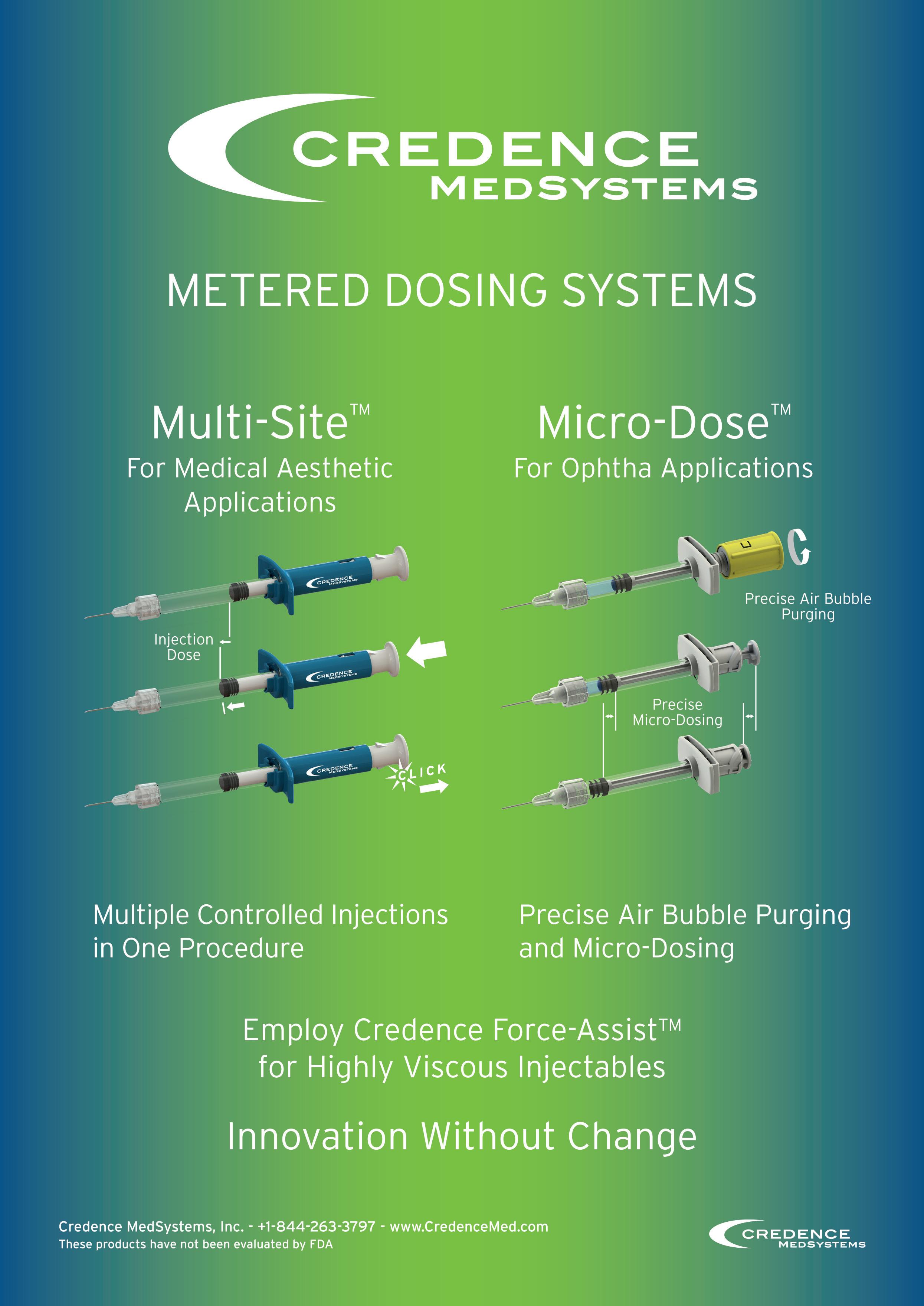

This edition is one in the ONdrugDelivery series of publications. Each issue focuses on a specific topic within the field of drug delivery, and is supported by industry leaders in that field.
EDITORIAL CALENDAR
Mar/Apr Skin Drug Delivery:
2023 Dermal, Transdermal & Microneedles
Apr Pulmonary & Nasal Drug Delivery
Apr/May Drug Delivery & Environmental Sustainability
May Injectable Drug Delivery:
Formulations & Devices
May/Jun Novel Oral Delivery Systems
Jun Connecting Drug Delivery
Jun/Jul Industrialising Drug Delivery
Sep Wearable Injectors
Oct Prefilled Syringes & Injection Devices
Oct/Nov Drug Delivery & Environmental Sustainability
Nov Pulmonary & Nasal Drug Delivery
Dec Connecting Drug Delivery
Jan 2024 Prefilled Syringes & Injection Devices
Feb Skin Drug Delivery:
Dermal, Transdermal & Microneedles
Mar Ophthalmic Drug Delivery
Apr Pulmonary & Nasal Drug Delivery
EDITORIAL:
Guy Furness, Proprietor & Publisher
E: guy.furness@ondrugdelivery.com
CREATIVE DESIGN:
Simon Smith, Creative Director (Freelance)
E: simon.smith@ondrugdelivery.com
SUBSCRIPTIONS:
Audrey Furness (subscriptions@ondrugdelivery.com)
Print + Digital subscription: £99/year + postage
Digital Only subscription: free.
ADVERTISING:
Guy Furness (guy.furness@ondrugdelivery.com)
ONdrugDelivery is published by Frederick Furness Publishing Ltd
The Candlemakers, West Street, Lewes East Sussex, BN7 2NZ, United Kingdom
T: +44 1273 47 28 28
Registered in England: Company No 8348388
ISSN 2049-145X print / ISSN 2049-1468 pdf
06 -09
A Sight for Sore Eyes: Challenges and Innovations in Ophthalmic Drug Delivery
Ethan Miller, Senior Biophysicist; and Kristien De Clercq, Senior Mechanical Engineer Springboard Pro
10 - 13
14 - 17
18 - 22
24 - 28
30 - 32
Beyond the Eyedropper Bottle – Three Ways to Improve Adherence
Nathan Wilkinson, Senior Consultant – Health Technologies; Catherine Wyman, Head of Eyecare; and Matt Parker, Senior Consultant – Drug Delivery
TTP
Topical Drug Administration for the Posterior Segment
David Bingaman, Chief Development Officer
Ora
MistGo® – A New Microdosing Eye Medication Delivery System
Rie Saabye, Director of Business Development; and Morten Jacobsen, Senior Project Manager, R&D
EYE-GO
Novelia®: A Clear Vision for Eye Care for Patients Globally Zoë Davidson, Global Category Manager for the Ophthalmic Franchise Nemera
Groundbreaking Trend for Preservative-Free Multidose Eye Drops in the US Rouven Kraus, Head of Sales Aero Pump
Drug Delivery Platform Drives New Opportunities for Continuous-Delivery Glaucoma Treatment
34 - 36
Harsh Patel, Senior Scientist, Pharma & Medical; Cyonna Holmes, Global Strategy Lead for Ophthalmology, Rare Diseases and RNA Therapeutics; and Brian Wilson, New Business Development, Pharma & Medical Celanese
Intravitreal Injections – More Than Meets the Eye: a Technical View of Product Use
38 - 42
Andrea Allmendinger, Chief Scientific Officer; and Hanns-Christian Mahler, Chief Enablement Officer ten23 health
Optimising Microlitre Dosing: Case Study with Intravitreal Injection
44 - 49
Yuki Takeuchi, Global Product Manager, PLAJEX Terumo Medical Care Solutions
Richard Whelton, Vice-President/Head of Business Strategy and Marketing Congruence Medical Solutions
Overcoming Challenges when Developing Oligonucleotides for Ophthalmic Drugs
50 - 52
Shiyan Chen, Study Director; and Binbin Tian, Study Director WuXi AppTec
ONdrugDelivery Magazine is printed sustainably by Newman Thomson Ltd, West Sussex, UK, using Forestry Stewardship Council® certified recycled paper, vegetable-based inks, biodegradable laminates and carbon balanced materials offset via the World Land Trust™ following ISO140001 processes.

Copyright © 2023 Frederick Furness Publishing Ltd
SUSTAINABLY
The ONdrugDelivery logo is a registered trademark of Frederick Furness Publishing Ltd.
The views and opinions expressed in this issue are those of the authors. Due care has been used in producing this publication, but the publisher makes no claim that it is free of error. Nor does the publisher accept liability for the consequences of any decision or action taken (or not taken) as a result of any information contained in this publication. Front cover image courtesy of EYE-GO (see EYE-GO’s article in this issue, p 18). Reproduced with kind permission.
www.ondrugdelivery.com/subscribe
The Ophthalmic Squeeze Dispenser from Aptar Pharma. The global leader in preservative-free multidose eye care devices.
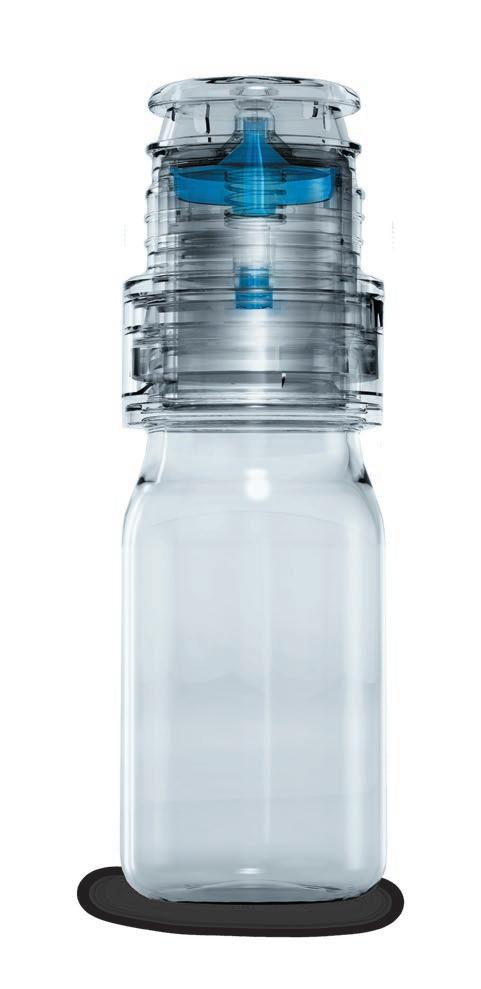
Anyone searching for a safe, stable, preservative-free and approved multidose eyecare device arrives at the same solution: Aptar Pharma.
Our Ophthalmic Squeeze Dispenser is the leading device for preservative-free prescription medications and over-the-counter products. With unrivalled microbiological safety, global acceptance by regulatory authorities and a proven track record, with over 400 market references worldwide, you need look no further.
See the difference with Aptar’s Ophthalmic Squeeze Dispenser:
• The first and only FDA-reviewed preservative-free multidose eye dropper
• A versatile technology platform offering a wide range of customized configurations to suit your formulations
• A range of services designed to accelerate and derisk your drug development time-to-market worldwide.
Look no further, the answer is right before your eyes.
Realize your next global eye care opportunity with our Ophthalmic Squeeze Dispenser. Contact Matthias Birkhoff, Vice President Business Development, Aptar Pharma, on +49 7732 801 132 or e-mail: matthias.birkhoff@aptar.com
Delivering solutions, shaping the future.

In this article, Ethan Miller, PhD, Senior Biophysicist, and Kristien De Clercq, Senior Mechanical Engineer, both at Springboard, discuss recent advancements and current challenges in the field of ophthalmology, including the trend towards preservative-free multidose delivery systems, delivering smaller topical volumes with increased drug efficacy, slow-release injections for delivery to the posterior of the eye and the exciting field of gene therapy.
This article discusses some of the big challenges of ophthalmic drug delivery and provides examples of innovative solutions for more effective, targeted and sustainable treatment. With rising rates in eye-related conditions, such as dry/wet macular degeneration, conjunctivitis, glaucoma and diabetic retinopathy, global demand for ophthalmic drugs is only growing. Many ophthalmic drug delivery methods are invasive, especially when targeting areas like the vitreous humour in the posterior eye (Figure 1). Even delivery to the anterior regions, like the cornea and sclera, has its challenges with controlling dosage and
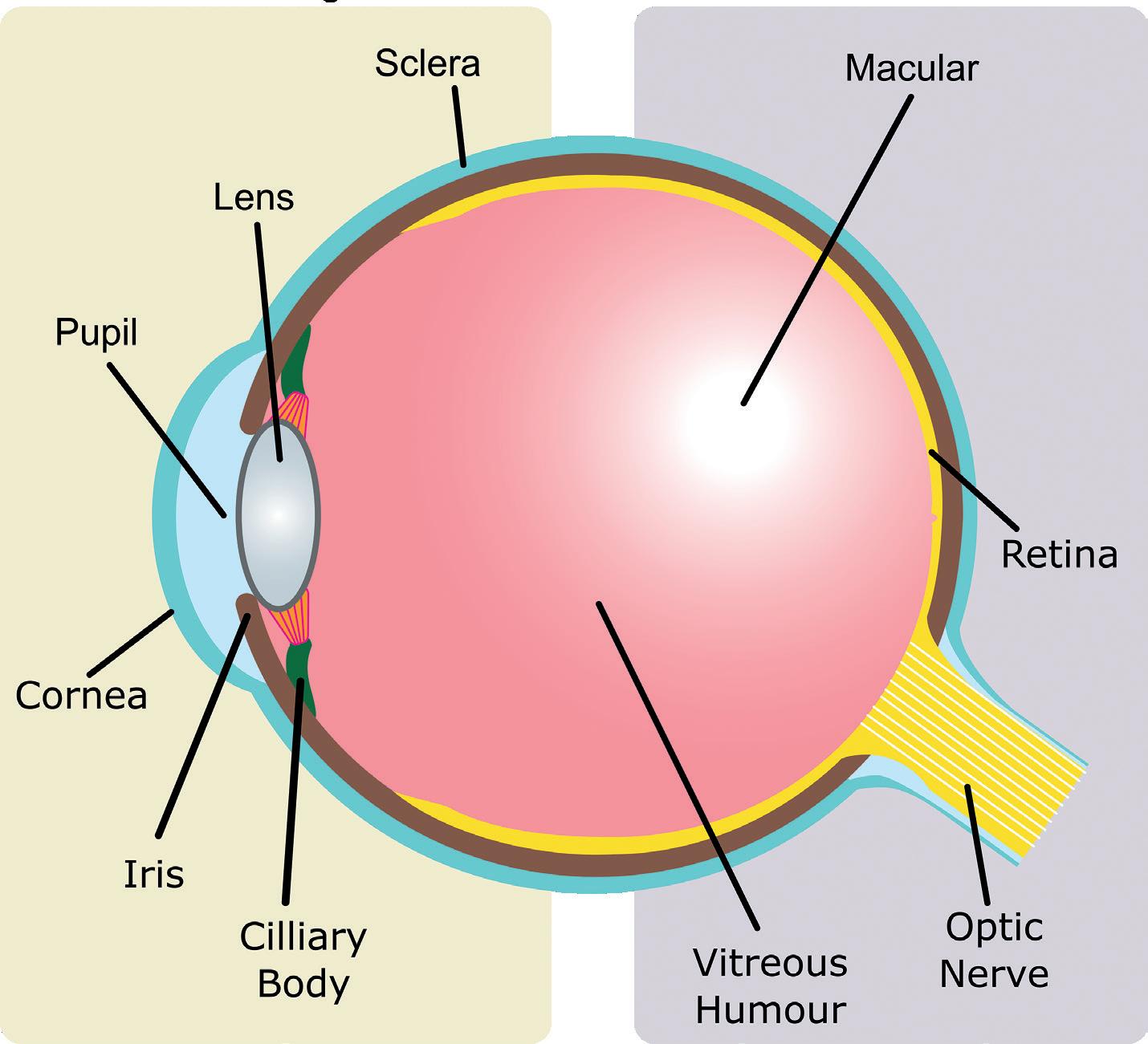
preventing contamination after multiple uses. Innovations in these areas are valuable, with global sales of ophthalmic drugs at US$35 billion (£29 billion) in 20211 and expected to grow to U$48 billion by 2030.2
Studies have shown that 24% of eye drops that are applied by patients become contaminated with micro-organisms,3 which can cause infections that lead to significant damage. Ophthalmic indications have drawn the attention of medical practitioners
Dr Ethan Miller
Senior Biophysicist

T: +44 1223 856 463
E: ethan.miller@springboard.pro
Kristien De Clercq

Senior Mechanical Engineer

T: +44 1223 607 466
E: kristien.declercq@springboard.pro
Springboard Pro Ltd
St John’s Innovation Centre
Cowley Road
Cambridge
CB4 0WS
United Kingdom
www.springboard.pro
for centuries, with historical evidence for the use of pastes to cure eye-related ailments.4 Since then, formulations have come a long way, but contamination remains a challenge with respect to the corneal epithelium, ulcers and even blindness.5


To deal with this, preservatives, such as benzalkonium chloride, are often added to formulations to act as antimicrobials. However, there are negative effects associated with their with long-term use. Benzalkonium chloride has been linked with Lachrymal film dysfunction, ocular hyperaemia, dotted keratitis and toxic keratopathy.6 While there is currently a strong movement towards preservative-free eye drops and topical applications, the issue of microbial contamination must still be addressed.
One way companies are overcoming this challenge is by revolutionising how eye drops are dispensed. For example, Aptar Pharma (IL, US) has developed a preservative-free multidose ophthalmic drug-device combination product – the Ophthalmic Squeeze Dispenser.7 This product uses a patented mechanical tipseal technology that creates a tight seal on the sterile formulation reservoir, dispensing a precise dose and filtering incoming air sterile through a 0.2 μm filter membrane. URSAPHARM (Saarbrücken, Germany) uses its COMOD system, which dispenses a single drop without introducing air or contaminants to sterile formulation, allowing for multiple safe, preservative-free doses. The ABAK® system from Théa Laboratories (Clermont-Ferrand, France) is another
These few examples demonstrate the innovative mechanisms that are being employed to maintain formulation sterility without the use of preservatives. However, these techniques are not without their challenges – they require robust seal integrity and rigorous verification and validation to comply with regulatory requirements.7 That said, if successful, they provide preservative- and contaminantfree devices that make eye care easier and more manageable for patients (Figure 2).
A common struggle with the application of ophthalmic drugs is dosage. A typical eye drop is around 40 μL in volume, even though the human eye can only hold approximately 7 μL of fluid,8 which results in significant wastage and poor dosage control of therapeutics. This is further compounded by patients incorrectly dosing their drugs – a study of glaucoma patients found that 90% of patients used an improper dosing technique,9 with a significant number of them missing the eye completely.10
Kedalion Therapeutics (CA, US), recently purchased by Novartis, has developed a novel multidosing method using an ideal stream. The proprietary AcuStream™ delivery system for topical ocular treatments delivers a gentle, continuous and reproducible stream of therapeutic directly to the eye, providing precision dosage.11 This means that less drug can be applied for a similar therapeutic effect, resulting in reduced drug wastage when compared with standard eyedroppers. The stream is applied horizontally, which allows patients to adopt a more natural posture, and is delivered in a fraction of a second to beat the blink reflex.
Eyenovia (NY, US) has developed a novel approach using microarray print technology in its Optejet device. This microdosing spray functions akin to an inkjet printer, generating a directional mist of microdroplets arranged to coat the corneal surface. With a typical volume of approximately 8 μL, this microdroplet array mitigates problems such as drug overflow. This method also offers increased precision, as the micro-array of droplets delivers the same amount of drug with 80% less corneal exposure, in turn reducing the risk of side-effects from preservatives.
Notably, the implementation of multidosing methods can also have positive impacts for sustainability, lowering drug and plastic waste and cutting associated carbon emissions. A recent study showed that consumer plastic waste can be reduced up to 7.5 times by switching from single- to multidose methods, helping tackle the issue of blow-fill-seals going to landfill waste.12 These novel multidose delivery systems are just a few examples of how such technologies can minimise incorrect dosing, simplify patient care and enhance the sustainability of the healthcare system.
Figure 2: When using eye drops, precision and technique matter for effective treatment of ophthalmic conditions. Advancements in eye care are happening at an accelerating rate, especially with new technologies providing a route towards easy-to-apply, multidose devices and preservative-free formulations. (Image credit: Yaroslav Shuraev / Pexels 2021.)
“While there is currently a strong movement towards preservative-free eye drops and topical applications, the issue of microbial contamination must still be addressed.”
Another way in which novel drug delivery systems are revolutionising the field of ophthalmology is by providing clinicians with more effective treatment options for ocular diseases. Intravitreal injections are injections are administered directly into vitreous humour (Figure 1) and are a common method for treating a range of diseases within the posterior of the eye, such as wet age-related macular degeneration. Intravitreal injections minimise systemic exposure but are not without risks, requiring careful patient monitoring and precise injection technique to minimise the potential for complications. These risks are only compounded when multiple injections are required for a single course of treatment.
The use of slow-release drugs is especially beneficial for posterior eye treatments as they enable sustained and controlled drug release over a long period of time, leading to better treatment outcomes, reduced dosing frequency and minimised side effects. For example, Ozurdex from AbbVie is a biodegradable intravitreal implant designed for the treatment of macular oedema and uveitis. The implant slowly releases dexamethasone, a potent corticosteroid, over a period of several months, providing sustained therapeutic effects. A single intravitreal injection is required to position the implant, significantly reducing the frequency of injections, and the device dissolves naturally so there is no need for additional surgery to remove the implant when treatment is finished.
VisusNano (London, UK), which was recently awarded £1.5 million in funding, has developed a drug-eluting artificial intraocular lens implant – MEDILens – for patients undergoing cataract surgery. The novel biodegradable polymer-based lens enables the slow, controlled release of antibiotic, anti-inflammatory and anti-proliferative agents, improving patient convenience.
Even purely mechanical solutions can be implemented, such as the iStent manufactured by Glaukos (CA, US). The iStent reduces intraocular pressure in patients suffering from open-angle glaucoma via a biocompatible titanium implant that improves the outflow of aqueous humour from the eye, thereby reducing pressure on the optic nerve.13
Innovative technologies for the delivery of drugs to the posterior region of the eye continue to be developed, creating new opportunities to provide better care and treatment to patients with ocular disorders, while also reducing associated risks, complications and providing more options to clinicians.

Upcoming innovations in ophthalmic drug delivery are likely to include gene therapy, an approach that involves the delivery of functional genes to affected cells in the eye. Genes are the instructions for how living things develop and function, providing the blueprints on how to make the specific proteins that are required for various functions of the body. Gene therapy acts to replace or repair defective genes – in the case of ophthalmology, restoring visual function.
Research on new methods to deliver the genes to cells is ongoing, such as by using the natural ability of viruses to penetrate and hijack cells, and using them to deliver therapeutic genes instead of their own genetic material (Figure 3). A serum containing such viruses, or “vectors”, would typically be injected into the target tissue to initiate treatment.
However, many challenges remain in this field of development. For example, to achieve the desired results, therapies must contain a complex cocktail of agents, including tissue-specific promoters,
“Intravitreal injections minimise systemic exposure but are not without risks, requiring careful patient monitoring and precise injection technique to minimise the potential for complications.”
enhancers and other factors involved in targeted transcription and translation.14 Advances are being made, with new vectors and gene delivery systems making good progress – for example, inhibitors of the RTP801 gene for treating microvascular illness16 and a treatment for Leber congenital amaurosis, a severe form of inherited blindness, using adeno-associated virus vectors to deliver a functional copy of the RPE65 gene to retinal cells.15
Ongoing clinical trials are providing encouraging results and suggest that this approach could indeed revolutionise how ocular disorders are treated in the near future. Gene therapy could provide a means to prevent, cure and even reverse many ocular disorders, using the body’s own cellular machinery to restore vision impairments untreatable by conventional means.
In conclusion, the field of ophthalmic drug delivery has seen significant advancements in recent years, with new technologies and innovations addressing longstanding industry challenges. Preservative-free multidose systems have made it easier to administer drugs to patients, while simultaneously reducing the risk of adverse reactions and improving patient comfort; the application of sustainedand controlled-release drugs means many treatments to the posterior region of the eye now require fewer intravitreal injections while remaining just as effective; and gene therapy is showing promising results in treating inherited eye diseases.
These advancements are greatly benefiting patients and providing more effective treatments for a range of eye conditions. Although challenges related to personalised treatments, bioavailability and sustainability still need to be addressed, it can be anticipated that the emergence of further innovative solutions will enhance the safety and efficacy of ophthalmic drug delivery.
Springboard is an engineering consultancy that specialises in developing devices from concept to manufacture for regulated
markets. The company is an expert in creating innovative yet robust designs and solving difficult technical problems quickly. Springboard does not have internal projects so is as fast and cost-effective as possible, and the intellectual property belongs entirely to the client.
1. “Ophthalmology Drugs Market accelerating at a CAGR of 7.2% from 2023 to 2030”. Pharmiweb, Jan 2023.
2. “Ophthalmic Drugs Market Report to 2030”. Visiongain, Nov 2020.
3. Daehn T et al, “Contamination of multi dose eyedrops in the intra and perioperative context”. Sci Rep, 2021, Vol 11, article 20364.
4. Abelson MB, Lafond A, “3,500 Years of Artificial Tears”. Review of Ophthalmology, Dec 2014.
5. da Costa AX et al, “Microbial Cross-contamination in Multidose Eyedrops: The Impact of Instillation Angle and Bottle Geometry”. Transl Vis Sci Technol, 2020, Vol 9(7), p 7.
6. Coroi MC, Bungau S, Tit M, “Preservatives from the Eye Drops and the Ocular Surface”. Rom J Ophthalmol, 2015, Vol 59(1), pp 2–5.
7. Ritter A, Birkhoff M, “An Eye on the Future of Preservative-Free Drops”. ONdrugDelivery, Issue 130 (Mar 2022), pp 20–26.
8. Hardy A, “Eyenovia micro-array print therapeutics targeting various ophthalmic indications”. BioTuesdays, May 2020.
9. Stone JL et al, “An objective evaluation of eyedrop instillation in patients with glaucoma”. Arch Ophthalmol, 2009, Vol 127(6), pp 732–736.
10. Rotchford AP, Murphy KM, “Compliance with timolol treatment in glaucoma”. Eye (Lond), 1998, Vol 12(Pt 2), pp 234–236.
11. Noymer P et al, “Acustream™: Bringing Topical Ophthalmic Drug Delivery into the Modern Era”. ONdrugDelivery, Issue 94 (Jan 2019), pp 32–35.
12. Govindasamy G et al, “Limiting plastic waste in dry eye practice for environmental sustainability”. Ocul Surg, 2022, Vol 25, pp 87–88.
13. Samuelson TW, “iStent Trabecular Micro-Bypass Surgery”. American Academy of Ophthalmology, Nov 2017.
14. Souto EB et al, “Advanced Formulation Approaches for Ocular Drug Delivery: State-Of-The-Art and Recent Patents”. Pharmaceutics, 2019, Vol 11(9), p 460.
15. Bainbridge JWB et al, “Effect of gene therapy on visual function in Leber’s congenital amaurosis”. N Engl J Med, 2008, Vol 358(21), pp 2231–2239.
Dr Ethan Miller is a Senior Biophysicist at Springboard with a background in developing synthetic biological systems and high-resolution imaging. He is able to grasp new concepts and break down complicated problems quickly, allowing him to discover creative solutions. His experience includes medical device development, manipulation of synthetic bio-membranes with microfluidics and nanoscale surface characterisation.
Kristien De Clercq is a Senior Mechanical Engineer at Springboard with over nine years of experience as a consultant in medical device development. She has led and delivered projects across a wide range of medical fields, including specialist applications for ophthalmology and vascular conditions. As an engineering consultant, she is accustomed to communicating understanding effectively and applying it to develop innovative solutions. As a project leader at Springboard, she has a proven record of delivering technical excellence.
“Gene therapy could provide a means to prevent, cure and even reverse many ocular disorders, using the body’s own cellular machinery to restore vision impairments untreatable by conventional means.”
In this article, Nathan Wilkinson, PhD, Catherine Wyman and Matt Parker, all engineers at TTP, discuss the future outlook of ophthalmic drug delivery beyond the traditional eyedropper bottle, including new delivery technologies, sustainedrelease therapeutics and digital healthcare applications.



Ever since Alcon (Geneva, Switzerland) introduced the Droptainer in 1953, the “eyedropper” bottle has been the main platform for topical delivery to the eye. Most innovation since then has centred around formulation, with advances ranging from novel pharmaceutical products to more sophisticated rheologies.
Enabled by this remarkably simple delivery platform, the global market for eye drops and lubricants has grown to an estimated $15 billion (£12 billion).1 It is expected to continue to grow as ageing populations suffer a greater incidence of diseases such as glaucoma and dry eye.
However, despite commercial success, this delivery modality is associated with adherence rates as low as 62%.2 This can lead to suboptimal patient outcomes for marketed products and may even mask drug efficacy during late-stage large-scale clinical studies.
Additionally, it is expected that the market will increasingly look for products that offer greater convenience and comfort for patients and that make it possible for healthcare providers to track adherence and disease progression. Digital health solutions in particular could further drive adherence if the industry develops technologies to track successful delivery to the surface of the eye and the resulting improvements in patient outcomes. The challenge is to offer these innovations at a cost point commensurate with the high-
volume, low-margin markets currently still served by the eyedropper bottle. This article looks towards the future of ophthalmic drug delivery beyond the familiar eyedropper and considers how patient outcomes can be improved through the development of products that:
• Are easier to use, even for patients with limited dexterity
• Minimise lifestyle disruption and patient burden
• Improve adherence, patient monitoring and feedback through digital and connected devices.
Eyedropper bottles are difficult to use. In one study, nearly 20% of 678 participants reported difficulties getting a drop into their eye, 15% dispensed too many drops and 12% reported problems dispensing any drops at all.3 These statistics all worsen when considering patient groups with diminished dexterity, such as the elderly and young. Then, even with a successful delivery, an eyedropper administers four to five times the volume of the tear film. This results in drug wastage, the discomfort of eye drops on the cheek and a possible worsening of side-effects. All these consequences are undesirable for the patient or payer.
Products that tackle these ergonomic, aiming and dosing precision challenges are already starting to shift the industry (Figure 1). Novartis and Bausch Health (Laval, Canada) have signed agreements with device companies Kedalion Therapeutics (since acquired by Novartis) and Eyenovia (NY, US), respectively. Both companies’ devices use jetting technologies common in the printing industry to deliver fluids horizontally. While horizontal delivery is only a minor
Senior Consultant –Health Technologies
T: +44 1763 262626
E: nathan.wilkinson@ttp.com
of Eyecare
T: +44 1763 262626
E: catherine.wyman@ttp.com
Matt Parker
Senior Consultant – Drug Delivery
T: +44 1763 262626
E: matthew.parker@ttp.com
TTP PLC
Melbourn Science Park
Melbourn
Cambridgeshire
SG8 6EE
United Kingdom
www.ttp.com
“Since Alcon introduced the Droptainer in 1953, the “eyedropper” bottle has been the main platform to offer low cost and near universal formulation compatibility.”Catherine Wyman Head Dr Nathan Wilkinson
conceptual difference, it is considered to be more comfortable and convenient for patients as the user experience no longer involves tilting the head back and lifting an arm to achieve vertical alignment for drug administration.
Jetting technology also enables more precise dose control and delivery of volumes that are only one to two times that of the tear film. As well as addressing user concerns associated with overdosing, more precise dosing offers the opportunity of greater flexibility in drug loading during pharmaceutical development. Conversely, this flexibility in drug loading may come at the expense of reduced flexibility in formulation, since these jetting systems are inherently more sensitive to the rheology of the fluid compared with eyedropper bottles.
From an industry perspective, another drawback of these solutions is the increased cost and complexity the devices. The manufacturing costs of the electromechanical solutions offered by Kedalion and Eyenovia are several orders of magnitude greater than those of a standard eyedropper. Devices of this cost are only likely to be suitable for high-value therapies as companies look to preserve their margins with existing eyedroppers. However, if these devices improve adherence and patient outcomes as expected, then replicating these benefits at a lower price point will become a priority in the industry, especially for those targeting the lucrative dry eye and allergy markets traditionally served with low-cost devices.
Justifying the development of more complex topical delivery systems can be challenging and, at first glance, the reclassification of eye drops as combination products may seem to raise this barrier even further. However, the acknowledgement that the device is central to the efficacy of the therapy may present opportunities for intellectual property strategies, such as those seen in inhalation therapies. In this sphere, companies like Boehringer Ingelheim (Ingelheim am Rhein, Germany) have maintained continued market exclusivity with device patents that last far longer than those of the initial pharmaceuticals. A company’s position in the market may therefore be protected through device innovation long after drug exclusivity expires. Alongside growing evidence for improved patient outcomes, this consideration may spur innovation and allow companies to justify developments that have previously been considered too high risk.
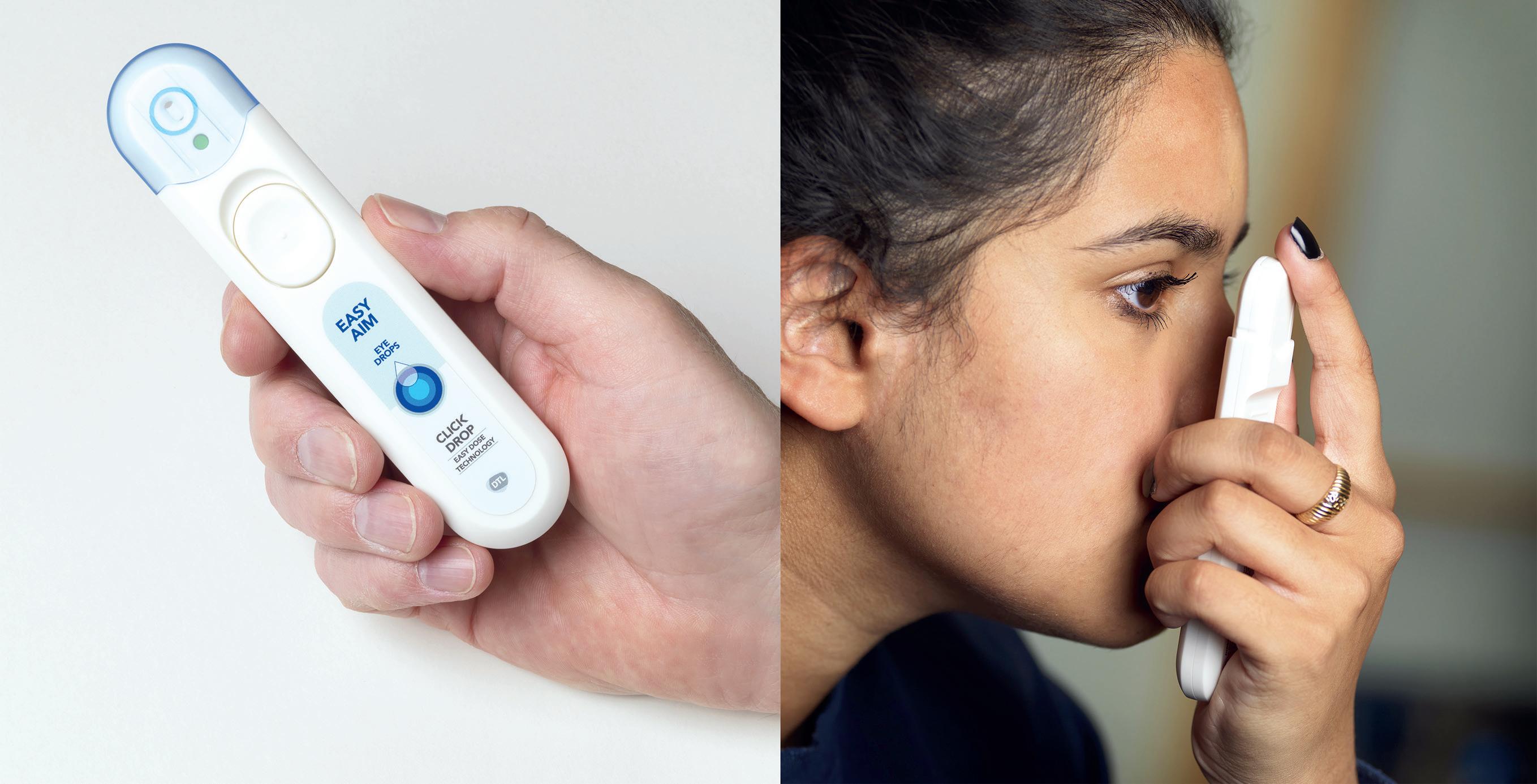
In addition to technologies that simplify drug delivery, sustainedrelease products, which deliver therapies over an extended period, are another way to improve both adherence and patient quality of life. Many therapies require eye drops to be delivered multiple times per day, which disrupts patients’ lives and, ultimately, leads to lower adherence. Technologies that enable application less frequently than once per day can lead to improved quality of life. Products that accomplish a therapeutic effect that lasts weeks or months from a single procedure can go even further towards increasing adherence.
Sustained-release products act as drug depots that slowly dissolve, erode or diffuse to release their contained therapeutics (Figure 2). Products that have been developed for sustained topical delivery can largely be categorised as devices that sit on the ocular surface but away from the cornea, such as Lacrisert (Bausch + Lomb, Canada); devices that sit near the ocular surface, such as Ocular Therapeutix’s (MA, US) Dextenza® (dexameathasone); or drug-eluting contact lenses. A persistent challenge for devices that sit on the ocular surface is that they are felt as foreign bodies. This can manifest as a physical response, such as watering or irritation, or as general
“Justifying the development of more complex topical delivery systems can be challenging and, at first glance, the reclassification of eye drops as combination products may seem to raise this barrier even further.”
discomfort. Both act as a barrier to patient acceptance. Optimising the shape of dissolvable or erodible inserts for comfort is more challenging than for contact lenses, as the rate of drug release is highly sensitive to surface area. Placement of devices on the ocular surface can also lead to loss of the insert, interference with vision and challenges with insertion.
Dextenza is placed in the lacrimal punctum to deliver corticosteroids to the ocular surface for up to 30 days. This approach helps avoid the foreign body sensation but introduces new challenges as placement in the punctum forces a trade-off between the dissolution profile, drug volume and longevity of the implant. Correct placement of the device is more difficult than for devices that sit on the ocular surface and is usually done by a clinician. Understanding how devices and formulations can be designed to work within the constraints of the punctum will be essential if this approach is to be translated to chronic diseases, such as dry eye.

Contact lenses are an attractive platform for sustained-release drug delivery, especially as their design has long been optimised for comfort. Johnson & Johnson’s launch of contact lenses for allergy relief, Theravison®, will be a long-awaited litmus test for the
technology. If Theravision achieves commercial success, a race to develop chemistries and manufacturing processes that enable drugeluting contact lenses in more therapeutic areas is likely to follow. However, more broadly, sustained-release inserts for topical delivery are still in their infancy. It is likely that contact lenses can teach us much about the design of inserts that can provide sustained drug delivery to the ocular surface without causing user discomfort.
As with many previous waves in healthcare innovation, eye care has been at the forefront of the digital health transformation. Tools to support diagnosis are already on the market and digital therapeutics are starting to change how diseases such as amblyopia are treated. Yet, despite these successes, digital tools and connected products to support patient adherence are proving to be slow coming to market. Payers are expressing willingness to reimburse digital and connected products. However, building evidence to demonstrate their efficacy presents an interesting challenge for the eye-care industry.
For eyedroppers, there is no well-established approach for detecting successful delivery to the ocular surface, which is required for direct tracking of adherence. Most attempts at dose tracking monitor device use through detection of lid opening, changing bottle mass or ejection of a droplet. While this approach provides insight around the user’s intent to adhere, it does not capture non-adherence as a result of poor aiming. Devices like e-Novelia® by Nemera (Lyon, France) provide feedback for aiming, but no marketed drug delivery device can verify successful delivery of a therapeutic to the ocular surface.
“If Theravision achieves commercial success, a race to develop chemistries and manufacturing processes that enable drug-eluting contact lenses in more therapeutic areas is likely to follow.”
Alongside tracking a person’s success in delivering a therapeutic, digital health and connected products can play a key role in maintaining the motivation of patients to adhere to therapies. Products that provide feedback on biomarkers related to patient outcomes could help determine the efficacy of treatments for chronic degenerative diseases. For example, a product that allows a patient to track their intraocular pressure (IOP) may drive adherence in glaucoma therapies. As an added bonus, this type of product ecosystem could also support clinical decision making by providing improved visibility of disease progression.
Products are beginning to emerge that will make this approach to managing eye disease possible. Implandata (Hannover, Germany) already has a CE-marked implantable device for measuring IOP. Implandata’s approach may be attractive for those already undergoing surgery for common comorbidities, such as cataracts, but the device alone is unlikely to justify an invasive procedure. The use of contact lenses to measure IOP is gaining traction and could provide a less-
Nathan Wilkinson, PhD, is a Senior Consultant – Health Technologies and a project head at TTP who is motivated to help clients accelerate the early stage of innovation, from product strategy and concept generation through to first in-human data. Dr Wilkinson has developed technology across healthcare, with highlights including ophthalmic drug delivery, sustainable respiratory care, surgical robotics and cell therapy manufacturing. Dr Wilkinson holds a PhD in Mechanical Engineering, where he helped create novel biocompatible sensors and actuators.
Catherine Wyman is Head of Eyecare at TTP, where she is a subject matter expert and oversees projects ranging from novel drug delivery systems through to complex diagnostic, imaging and surgical tools. She has spent her career developing medical devices, with contributions ranging from detailed mechanical design of novel inhalers through to complex electromechanical and software projects. A University of Cambridge-educated mechanical engineer, in recent years Ms Wyman has focused on technology strategy in the eye care space.
Matt Parker is a Senior Consultant – Drug Delivery and a project lead at TTP. With a background in mechanical engineering, he has led multidisciplinary teams developing next-generation devices across drug delivery, rapid diagnostics and biosensors. Mr Parker’s experience stretches from early concept development through taking devices from first prototypes to clinical trials.
invasive alternative – but it remains to be seen how the performance of these devices will compare with the gold standard of tonometry. Triggerfish®, by Sensimed (Etagnières, Switzerland), is the only approved IOP-detecting contact lens device; however, its approval is based around understanding temporal variation in IOP rather than magnitude. In the short term, at-home tonometers may be capable of supporting biomarker-based feedback, but it remains to be seen whether they will be widely accepted by patients.
The challenges associated with traditional eyedroppers and the innovation discussed here signal major change for topical ophthalmic delivery. Companies are looking to introduce new topical delivery platforms as product portfolios are re-evaluated in response to longterm trends towards multidose, preservative-free packaging; changes to the EU Medical Device Regulations; and recent reclassification of eye drops as combination products. At the same time, the explosion of digital health and increased competition in consumer health is driving up patient expectations and opening new opportunities for innovators. The one-size-fits-all model is becoming outdated – products need to fit the lifestyle and needs of patients to remain competitive and deliver the best health outcomes for patients.
TTP is an independent technology company. Its unrivalled combination of science and engineering means that it has the knowhow to help solve your toughest challenges. TTP can help you get world-class technology to market – fast. The company’s teams find better solutions faster because its consultants are uniquely empowered to collaborate with clients, and each other, in a truly agile way. This has been a cornerstone of the company’s success for over 30 years, allowing TTP to develop and deliver thousands of pioneering products and services. From start-ups to blue chip organisations, what unites TTP’s clients is their desire to make brilliant things happen.
1. “Eye Drops and Lubricants Market Size, Emerging Trends and Will Generate New Growth Opportunities Status 2022 to 2030”. Press Release, Report Ocean, Jan 2023.
2. Tse AP et al, “Glaucoma treatment adherence at a United Kingdom general practice”. Eye (Lond), 2016, Vol 30(8), pp 1118–1122.
3. Mehuys E et al, “Eye drop technique and patient-reported problems in a real-world population of eye drop users”. Eye (Lond), 2020, Vol 34(8), pp 1392–1398.
A number of potentially game-changing innovations in retina research are currently in development, including stem cell and gene therapies, bispecific biologics and biosimilars, as well as topical eye drops that hold the potential to effectively treat posterior segment ophthalmic conditions, such as age-related macular degeneration (AMD) and diabetic eye disease. An approved topical eye drop for retinal disease would have the potential to provide a much less invasive option than the currently available management options, such as intravitreal injections and surgically implanted sustained release devices.
There are various challenges when considering the treatment of these visually debilitating retinal conditions, including limitations on how much of the drug reaches the intended tissue and the increased concentrations required for tissue penetration. If effective, such a topical drug delivery method could improve the quality of patients’ lives and provide an alternative to repeated surgical procedures for retinal vascular and degenerative diseases.
Over the last two decades, breakthrough treatments have been approved for the treatment of retinal vascular diseases, such as wet AMD and diabetic macular oedema (DME), all requiring in-office treatments by an ophthalmologist, most of which need to be repeated frequently. Prior to intravitreal (IVT) anti-vascular endothelial growth factor (anti-VEGF) therapy, laser photocoagulation and photodynamic therapy (PDT) were the standard of care for choroidal neovascularisation (CNV).
Laser photocoagulation consists of the use of focused laser spots to treat areas of oedematous retina to prevent further retinal thickening and the resultant diseased retinal tissue. PDT involves the administration of an intravenous photosensitiser, verteporfin, after which a laser is applied to the affected area of CNV, which prevents it progressing further into the surrounding retina. Both therapies have the limitation of restricted improvements of affected vision and CNV recurrences post-therapy.1
Intravitreal anti-VEGF injections were a historical advancement in patient care, working to reduce pathologic vascular leakage and prevent further abnormal new vessel growth through the local administration of biologics, such as ranibizumab, bevacizumab or aflibercept, into the vitreous chamber. The most recent IVT biologic approved, faricimab, impacts both the VEGF and angiopoietin signalling pathways.
Several limitations associated with IVT injections exist, including the requirement for repeated, sometimes frequent, in-office procedures, as recommended by a patient’s eye-care practitioner. These treatments can be uncomfortable, or even painful, for a patient, and visits often require family member involvement.1 These factors may lead to substantial long-term noncompliance with frequent treatments and a resulting worsened visual prognosis.
Although rare, there are also several risks associated with IVT injections, including potentially blinding complications, such as retinal detachment or endophthalmitis. More recent advancements have focused on durable delivery platforms, with IVT
Dr David Bingaman Chief Development Officer
T: +1 978 685 8900
E: dbingaman@oraclinical.com
Ora, Inc
300 Brickstone Square Andover MA 01810 United States
www.oraclinical.com
In this article, David Bingaman, DVM, PhD, Chief Development Officer at Ora, explores the potential benefits of topical administration for diseases affecting the posterior segment of the eye.“To avoid frequent and invasive therapeutic options for degenerative and vascular retinal disease, there is a need for less-invasive treatment options.”
implants becoming more popular, as they can provide sustained release drug administration – eliminating the need for repeated IVT injections. IVT implants are surgically implanted into the eye, usually under local anaesthesia and, depending on the implant, can slowly release their designated drug over a period of three months up to two-and-a-half years. There are similar risks and drawbacks to IVT anti-VEGF injections, including the risk of visually debilitating complications. Along with this, some implants are not biodegradable and therefore need to be surgically removed from the eye.1
To avoid frequent and invasive therapeutic options for degenerative and vascular retinal disease, there is a need for less-invasive treatment options, either replacing the currently available therapies or as a concomitant therapy to lessen the need for repeated in-office procedures. This is especially true with the advent of patient-involved disease assessments, such as home retinal imaging, and in areas where retina specialty care is difficult to obtain.
Although it is rarely discussed in this context, the use of topical eye drops (Figure 1) to treat posterior segment disorders has been ongoing for quite some time as a topical therapy for lowering intraocular pressure to treat ocular hypertension and glaucoma, leading to preservation of retinal function. However, anti-hypertensive therapies are targeted to the ciliary epithelium or uveoscleral outflow system, not direct intervention at the posterior pole. Retinal indications, such as AMD and diabetic retinopathy (DR), would require pharmacodynamic activity in the outer and inner retina, respectively. Nonetheless, effective and safe topical therapy could potentially augment or replace currently available surgical therapy, or be used as a rescue method for invasive treatment.
In contrast to surgical procedures, topical eye drops have the potential to minimise the treatment burden for patients and caregivers, as fewer in-office injections may be required, which could enhance the accessibility and compliance of these treatments.2,3 Although rare, invasive procedures like IVT injections can be painful and come with several vision-disabling risks, including ocular inflammation and infection.1,4 These challenges, and the arduous logistics of maintaining chronic recurring visits, may cause patients to refrain from showing up to their followup treatments. The use of topical drops, which can be instilled anywhere and at any time, can empower patients and/or their caregivers to work more effectively with their eyecare professional.2
As AMD and diabetes are longstanding conditions, the use of topical drops may contribute to sustainable treatment regimens for lifelong therapy. In the future, topical drops may support a prophylactic care option for highly motivated patient populations with late-stage nonproliferative DR and intermediate AMD, potentially decreasing the risk of vision loss associated with the later stages of both diseases. As a result, this may lead to fewer in-office visits and a decreased need for patients or caregivers to take time off work – and therefore provide meaningful socioeconomical impact.

Novel methods of drug delivery come with new challenges for ensuring that biologically active concentrations reach the target tissue of interest. With topical eye drops for retinal disease, numerous obstacles must be overcome to deliver effective drug concentrations to the cellular target(s) of interest. When a topical ocular drop is instilled, a blinking reflex occurs, pushing a substantial portion of the drop volume through the nasolacrimal drainage system, and possibly out of the palpebral fissure. Additionally, the tight cellular junctions of the corneal epithelium act as a barrier to drug entry.1 Mastering the exact pharmacokinetics and distribution of an API is key to determining its ability to be delivered to the posterior segment, which includes the molecular size of the API, its lipophilicity and its pH.5
Since topical ocular drugs are absorbed through the conjunctiva, a portion of the drug substance or API is absorbed into the patient’s systemic circulation. This systemic absorption will reduce the available API that can penetrate to the targeted retinal tissue(s), resulting in subtherapeutic treatment and/ or potential systemic adverse reactions.1 These, and other related challenges, have to be considered when selecting the specific physicochemical properties of the API and
“Effective and safe topical therapy could potentially augment or replace currently available surgical therapy.”
formulating candidates. Innovative features of these molecules and/or their drug product formulations include topical drugs that travel around the peripheral ocular tissue to the posterior pole versus direct axial penetration through the cornea and ocular fluids into the central retina.2
To enhance delivery of topical ocular treatments to the posterior segment, very specific formulations have been developed, including nanotechnology, hydrogels and cell-penetrating peptides (CPPs).6,7,8 Nanoparticle technology can be used to augment the solubility of hydrophobic drugs, administering a sustained release of a therapeutic while ensuring lower toxicity. Nanoparticles can also prolong ocular surface retention, providing sustained drug release, improving penetration through ocular tissues and achieving tissue-specific localisation.6
Along with nanotechnology, hydrogel carriers, which are composed of hydrophilic polymer chains for water retention, can assist with controlled release and easy delivery of liquid-gel formulations.7
Finally, CPPs have been investigated as penetration enhancers (PEs) for drug delivery and biodistribution to the retina and choroid. CPPs have also exhibited the capacity to carry protein therapies, nanoparticles and several other constituents to the posterior segment from a topical eye drop instillation.8 These carriers have been evaluated for delivery of anti-VEGF therapies in neovascularised retina models and have displayed no significant difference between the topical drops and IVT anti-VEGF methods.9
The pipeline of novel treatments for retinal vascular and neurodegenerative diseases is a very active space. The unique mode of topical ocular delivery is a potential differentiator from those innovations that rely on more invasive and risky delivery platforms.
Alcon Nepafenac®
Compelling clinical research has been conducted analysing the effect of topical nepafenac, a Cox 1/2 inhibitor or nonsteroidal anti-inflammatory drug (NSAID), used prophylactically to prevent macular oedema occurring following cataract surgery in patients with diabetes.10,11 Topical nepafenac 0.3% dosed once per day may improve patient surgical outcomes and has the potential to decrease the burden patients experience with post-cataract macular oedema (PCME), including further in-office treatment, specifically for patients who are at high risk of developing PCME.
Patients at risk may include those diagnosed with diabetes and some other ocular conditions, such as AMD, uveitis and retinal vein occlusion (RVO), and patients who have a history of PCME in their other eye.10 Although these clinical findings may be associated with reduced inflammation in the anterior and posterior chambers following nepafenac treatment, topical nepafenac has been shown to directly inhibit the posterior segment vascular complications associated with diabetes mellitus, as well as neovascularisation.11,12
Oculis OCS-01 is a topical ophthalmic drug candidate for the treatment of DME. OCS-01 incorporates dexamethasone in Oculis’ (Lausanne, Switzerland) proprietary OPTIREACH solubilising nanoparticle technology, which enhances bioavailability to the posterior segment. OCS-01 has completed two Phase II clinical studies, one for the treatment of DME and the other for the treatment of inflammation and pain following cataract surgery, with both indications moving into Phase III studies.13 For DME, the Phase II studies exhibited positive patient benefit, demonstrating that OCS-01 was more effective in decreasing central macular thickness and improving visual acuity in patients with DME versus vehicle. This drop was found to be well tolerated, with no significant adverse effects noted.14
OcuTerra Therapeutics (Boston, MA, US) is developing a topical therapy called
OTT166 for the treatment of moderately severe to severe non-proliferative diabetic retinopathy and mild proliferative diabetic retinopathy. OTT166 is a novel smallmolecule selective integrin inhibitor that has undergone two multi-centre, randomised Phase Ib clinical trials, which exhibited safety, tolerability and proof of biological activity. The Phase II Diabetic Retinopathy: Early Active Management (DR:EAM) study is currently underway to determine efficacy, safety and best dosing for OT166.15
Another novel topical eye drop candidate of note is PanOptica’s (Arlington, NJ, US) PAN-90806, which is intended to be a once-daily drop for the treatment of wet AMD and other neovascular eye diseases. This small molecule blocks VEGF signalling by potently inhibiting the tyrosine kinase activation of VEGF receptor two. Although other companies, such as GSK and Bayer, have attempted to develop topical ocular kinase inhibitors for retinal diseases, PanOptica’s molecule has several unique physicochemical properties that provide differentiation, allowing it be absorbed by peripheral ocular blood vessels and delivered around the eye to the central choroid and retina versus via a transcorneal route.2 PAN-90806 suspension underwent a double-masked, dose-ranging Phase I/II clinical trial for patients with wet AMD where more than 50% of treatmentnaïve participants receiving PAN-90806 completed the study and did not require emergency anti-VEGF injections and 88% of these participants displayed stability or improvement. No severe adverse effects were noted.16 Zhaoke recently announced licensing of topical ocular PAN-90806 for ophthalmic development in specific Asian jurisdictions.17
With no current available treatments for dry AMD, Mitotech (Luxembourg) has been innovating a potential topical ocular treatment for this vision-debilitating disease, called Visomitin (SKQ1 eye drops).18,19 Visomitin holds a small-molecule cardiolipin peroxidation inhibitor, which transports plastoquinone, an exceedingly active antioxidant, to the mitochondria, specifically the inner leaflet of the inner mitochondrial membrane. Once delivered, it works as a target scavenger of reactive oxygen species and a cardiolipin
“The pipeline of novel treatments for retinal vascular and neurodegenerative diseases is a very active space.”
protector in outer retinal tissues. Visomitin accumulation can prevent lipid degeneration, which may prevent mitochondrial dysfunction and apoptosis, as well as uncontrolled inflammation.18 Although Visomitin has only been studied in ocular surface diseases to date, it is reported to be Phase II ready for the treatment of dry AMD.19
As the global population continues to age, the prevalence of degenerative and vascular retinal diseases also continues to rise. Therefore, novel drug delivery systems will be essential to ensure patient compliance and comfort with necessary chronic administration. Several therapeutic candidates in the ophthalmic development pipeline may provide an effective and safe alternative or adjunct to the monotonous, uncomfortable and sometimes anxietyinducing invasive in-office treatments that are currently approved for use. Overcoming some of the potential anatomical barriers and compliance challenges associated with topical ocular delivery to the retina will be pivotal in bringing these novel therapies to market and providing additional benefit to patients with unmet needs.5
Ora is a leading full-service ophthalmic drug and device development firm with offices in the US, UK, Australia and Asia. For over 40 years, Ora has helped clients
earn more than 55 product approvals and create vision beyond what they see. The company supports a wide array of organisations, from start-ups to global pharmaceutical and device companies, to efficiently bring their new products from concept to market. Ora’s preclinical and clinical models, unique methodologies and global regulatory strategies have been refined and proven across thousands of global projects. The company brings together an extensive and experienced team of ophthalmic experts, R&D professionals and operations management to maximise the value of new product initiatives.
1. Cabrera FJ et al, “Challenges and opportunities for drug delivery to the posterior of the eye”. Drug Discov, 2019, Vol 24(8), pp 1679–1684.
2. “A new wave of innovation in Neovascular Eye Disease”. Web Page, PanOptica, accessed Feb 2023.
3. Boyer DS, “Topical drug delivery for retinal disease management”. Retina Today, 2018.
4. “Ocular drug delivery: Targeting the posterior segment”. Ora Clinical, 2017.
5. Löscher M et al, “Topical drug delivery to the posterior segment of the eye”. Pharmaceutics, 2022, Vol 14(1), p 134.
6. Meza-Rios A et al, “Therapies based on nanoparticles for Eye Drug Delivery”. Ophthalmol Ther, 2020, Vol 9(3), pp 1–14.
7. Cooper RC, Yang H, “Hydrogelbased Ocular Drug Delivery Systems: Emerging Fabrication Strategies, applications, and bench-to-bedside manufacturing considerations”. JCR, 2019, Vol 306, pp 29–39.
8. Thareja A et al, “Penetration enhancers for topical drug delivery to the ocular posterior segment –a systematic review”. Pharmaceutics, 2021, Vol 13(2), p 276.
9. De Cogan F et al, “Cell-penetrating
peptides as non-invasive drug delivery vehicles for ranibizumab and bevacizumab”. IOVS, 2016, Vol 57, p 4037.
10. Yüksel B, Kartı Ö, Kusbeci T, “Topical nepafenac for prevention of post-cataract surgery macular edema in diabetic patients: patient selection and perspectives”. Clin Ophthalmol, 2017, Vol 11, pp 2183–2190.
11. Takahashi K et al, “Topical Nepafenac Inhibits Ocular Neovascularization”. IOVS, 2003, Vol 44(1), pp 409–415.
12. Kern TS et al, “Topical Administration of Nepafenac Inhibits Diabetes-Induced Retinal Microvascular Disease and Underlying Abnormalities of Retinal Metabolism and Physiology”. Diabetes, 2007, Vol 56, pp 373–379.
13. “OCS-01: A potential paradigm shift in diabetic macular edema (dme) treatment”. Web page, Oculis, accessed Feb 2023.
14. “OCULIS announces publication and presentation of phase 2 data showing topical OCS-01 improves macular thickness and visual acuity in patients with diabetic macular edema”. Press Release, Oculis. Sep 6, 2022.
15. “Pipeline”. Web Page, OcuTerra, accessed Fen 2023.
16. “PanOptica Anti-VEGF eye drop shows promise in treatment of neovascular (wet) AMD”. Press Release, PanOptica, Oct 10, 2019.
17. “PanOptica Announces Licensing Agreement with Zhaoke Ophthalmology for the Treatment of Neovascular Eye Diseases in China, South Korea, and Southeast Asia”. Eyewire+, June 23, 2021.
18. “Visomitin®: A Cardiolipin peroxidation inhibitor”. Web Page, Mitotech, accessed Feb 2023.
19. “Clinical programs”. Web Page, Mitotech, accessed Feb 2023.
David Bingaman, DVM, PhD, serves as the Chief Development Officer of Ora, where he oversees all clinical and non-clinical activities that directly impact customers around the world. With his background and leadership, Ora continues to elevate customer, patient and partner experiences while delivering outstanding development programmes. Before joining Ora, Dr Bingaman served in large public entities and small privately-held biotechnology companies. Prior employers include Alcon Laboratories, Alcon/Novartis, PanOptica and, most recently, Oculis, where he held the role of Vice-President and Head of Global Clinical Development. Dr Bingaman is a board-certified veterinary ophthalmologist with a PhD in Ocular Angiogenesis, patent holder, author and speaker.
“Novel drug delivery systems will be essential to ensure patient compliance and comfort with necessary chronic administration.”
Here, Rie Saabye, Director of Business Development, and Morten Jacobsen, Senior Project Manager, R&D, both at EYE-GO, discuss the benefits of a new microdosing eye medication delivery system for chronic ophthalmic diseases, such as dry eye disease and glaucoma.
According to the WHO, eye conditions are remarkably common, with 2.2 billion people having a distance or near presenting vision impairment globally, and population growth and ageing are expected to increase the risk of more people acquiring a vision impairment. Vision impairment affects people of all ages, with the majority being over the age of 50. Young children with early onset severe vision impairment can experience lower levels of educational achievement, while in adults it often affects quality of life through lower productivity, decreased workforce participation and high rates of depression.1

Of the various routes to administer drugs to the eye to treat chronic diseases, such as dry eye disease (DED) and glaucoma, the topical route is the most commonly used. Proper administration and strict patient adherence to the prescribed therapeutic regimen are important to ensure safe and efficacious use of topical ocular therapies and to preserve vision for patients with chronic conditions.2–5 On the other
hand, improper instillation techniques can lead to treatment failure, adverse events and a potential risk of serious infectious complications.6–10
However, many patients struggle with medication adherence; systematic reviews estimate medication non-adherence rates can be as high as 80%.11 Additionally, a patient may purport to be adherent but actually be using a medication incorrectly or not taking any medication due to difficulty self-administering drops. Numerous studies in the US and other countries have documented that poor technique is a considerable concern in non-adherence.12
The way topical medication is administered by patients has not changed much in a century. Patients are still relying on dropper bottles, trying to instil just a single drop into the eye with the head in awkward positions, as illustrated in Figure 1.

On top of that, even if the patient successfully instils just one drop from a conventional eyedropper –delivering highly variable 30–50 µL drops that greatly exceed the physiologic 6-8 µL ocular tear film capacity13,14,15 – the overdosing floods the eye with excess drug compounds and preservatives, resulting in ocular surface and systemic toxicity.16,17
Collectively, these findings emphasise the need for an improved delivery technology for topical ophthalmic therapies.
Rie Saabye Director of Business Development T: +45 3014 3716 E: rs@eye-go.com Morten Jacobsen Senior Project Manager, R&D
T: +45 4191 0813
E: mja@eye-go.com
“A patient may purport to be adherent but actually be using a medication incorrectly or not taking any medication due to difficulty self-administering drops.”
The Danish MedTech company EYEGO has developed a new-generation microdosing delivery system for topical ophthalmic therapies, eliminating the well-known barriers of conventional eyedroppers. MistGo®, shown in Figure 2, is designed with the user in mind to ensure a successful instillation every time. It releases a gentle optimal mist dose of down to 6 µL evenly and precisely across the cornea of the eye for optimal drug delivery. It is compatible with multiple atomisable substances and hence useful for many chronic eye diseases. The aim of MistGo® is to let the topical ophthalmic therapy perform at its best with adherent patients enjoying the full treatment benefits without exposure to unnecessary side effects.
Evaluations of eye-drop selfadministration show that 34–92% of patients use improper instillation techniques,5,9,10,18–22 7–44% miss the eye completely, 9,18,20-21,23,24 and 18–80% contaminate the tip of the bottle by contacting the eye or surrounding tissue.1,7–10,18,20–27 Additionally, up to 30% of patients instil a stream of fluid rather than the prescribed number of drops, resulting in excessive delivery and increasing the risk of local and systemic adverse events.21
Adherence status has been found to be statistically associated with the instillation technique of topical glaucoma medications. Adherence and instillation proficiencies are interconnected, meaning that poor practice in instillation could jeopardise adherence and vice versa.5 MistGo® is intuitive, easy and comfortable to use, even for seniors
and children, and creates a better user experience, which translates into higher patient compliance, healthier eyes and higher quality of life for patients.
MistGo® is omnidirectional – it can be used horizontally, as depicted in Figure 3, or in any head position preferred. It has an integrated eye interface to be placed around the eye socket to ensure a safe topical administration precisely to the cornea without having to tilt the head in an unnatural position and without accidentally touching the eye with the device.


In a 2019 usability study conducted by an independent institute with a sample of participants above the age of 50, MistGo® was rated 8.44 when asked “on a scale from 1–10, how would you rate the user friendliness of the product?” and 9.94 when asked “on a scale from 1–10, how confident would you feel to dispense a mist to the eye with the product at home?”
Visit EYE-GO’s website for an animation of how MistGo® is used.
Eye drops delivered in a multidose container must maintain the sterility of the contents throughout the intended lifespan of the product. Antimicrobial activity is often achieved through the addition of preservatives. The most frequently used
“MistGo® is designed with the user in mind to ensure a successful instillation every time.”
preservative, benzalkonium chloride (BAK), has consistently demonstrated its toxic effects in laboratory, experimental and clinical studies.28
Whilst BAK is known to be an effective antimicrobial agent, demonstrating efficacy against a wide variety of common pathogens, considerable evidence, often from its use in glaucoma medications, also exists detailing the deleterious effects it has on the ocular surface, particularly when used over an extended period of time. It can be argued that the undesirable effects of BAK have contributed to a movement into preservative-free topical preparations. Removal of the preservative naturally eliminates preservative-induced complications. In both glaucomatous and DED populations, use of preservativefree drops can improve signs and symptoms compared with BAK-containing formulations.29
A preservative-free eye medication must be dispensed in either a single-use vial or delivery systems specifically designed to keep the liquid formulation sterile throughout the treatment period. MistGo® is airtight and designed to maintain sterility in the following ways:
• MistGo® integrates a collapsible multilayer container (the cartridge), obviating the need to ventilate with contaminated air during multiple dosage. Therefore, there is no back flow of air that requires filtering.
• The liquid is sealed off from the environment using non-permeable material. Several barriers are further established to separatee the liquid from the environment, including a one-way valve.
• The system enables pressurised air to both create the mist and completely clean the outlet nozzle chamber after dispensing. This leaves no liquid for later microbiological contamination. The liquid column is broken and contamination is prevented.
• An eye interface protects the nozzle from contamination caused by contact with the user, and a lid helps protect the dosing chamber from contamination during storage between uses.
The cornea is the main route for topically applied drugs to gain access into the eye, although the conjunctival/scleral route can
also be efficient. However, efficient ocular drug delivery is hampered by a series of clearance mechanisms protecting the ocular structures from foreign matter, such as reflexive tearing or blinking, nasolacrimal drainage increasing precorneal drug dilution and clearance from the eye.30
The tear film covering the ocular surface is approximately 3–10 μL in volume, 3 μm thick and secreted at a rate of 1–2 μL/min.31 Commercial eye drops vary significantly between 25 and 70 µL. Typically, after instillation of an eye-drop, less than 5% of the applied drug penetrates the cornea and

reaches the intraocular tissues; the major fraction of the instilled drug is absorbed and enters systemic circulation, risking adverse effects. A smaller eye drop can achieve a maximal tear film concentration with far less systemic absorption. Hence, from a biopharmaceutical and economic point of view, the ideal would be to instill smaller volumes of 5–15 µL.32,33 Reducing the drop volume avoids the previously mentioned problems with overflow and may increase corneal absorption by reducing lacrimal drug dilution and tear loss due to blinking and drainage.34

“Reducing the drop volume avoids problems with overflow and may increase cornea absorption by reducing lacrimal drug dilution and tear loss due to blinking and drainage.”Figure 4: Droplet size distribution.
MistGo® contains a high-precision micropump, consistently metering a dose of 6 μL, dispensing no excess liquid that can irritate the skin or enter systemic circulation, risking adverse events. Compressed air is used to propel the mist out of the device at just the right velocity for the full dose to reach the cornea safely and comfortably before the eye can blink. The internal geometry of the nozzle is designed to vaporise the drug into a fine mist with a broad impact pattern, coating the entire cornea for optimal absorption (~10–12 mm diameter).
The mist contains mini droplets that vary in size, depending on viscosity, surface tension level and other characteristics of the drug. Figure 4 depicts vaporisation of the glaucoma drug latanoprost, resulting in a homogeneous distribution of droplets with a mean diameter of approximately 50 µm. Figure 5 shows misting of the glaucoma drug latanoprost with MistGo. Parameters inside MistGo® can be adjusted to suit the needs of individual drugs, enabling the delivery system to perform optimally for that specific liquid – allowing users to have an ideal experience of a soothing mist.
MistGo® received high scores on perceived comfort, with no bother at all from excess fluid after treatment, at a comfort study conducted together with the Department of Ophthalmology at the University Hospital in Copenhagen (Denmark) in 2021. The sample included patients aged 40–90 suffering from DED with mild to severe symptoms. On a scale from 1–5, the average score was 4.5 when asked, “To what extent do you prefer the mist over eye drops when treating your eye?”
EYE-GO is currently preparing for verification of the delivery system as well as setting up for design-for-manufacturing (DFM) for mass production. MistGo® is a delivery system that can be combined with eye medications. The US FDA and EU EMA have, over the last few years, expanded and clarified their requirements for drug-device combination products.
Under FDA regulations, therapeutic products combining a drug and a device are classified as combination products. When the drug will be the primary mode of action (PMoA), the Center for Drug Evaluation and Research (CDER) will be the primary regulatory branch evaluating and approving. Combination products are subject to 21 CFR Part 4, and the submission may follow the condensed 21 CF 4.4(b) filing, demonstrating compliance with both the drug cGMPs (21 CFR parts 210 & 211) and provisions of the device quality system regulation (21 CFR part 820).35
The EMA also regulates based on the PMoA, and if MistGo® is combined with Rx eye medication it will be defined as “medicinal product used in combination with a medical device”. The EMA has published a final guideline (taking effect January 2022) of the expanded requirements, including elements such as Annex 1 of MDR 2017/745.36,37 Drug manufacturers are required to submit a notified body opinion to the EMA confirming that the device meets the General Safety and Performance Requirements of MDR 2017/745 Annex 1 requiring data on risk management, safety, performance, functionality, usability, sterilisation validation and microbiology.38
With these increasing demands and stricter regulatory filing requirements,
Rie Saabye has, over the last 20 years, been focusing on business development internationally, including strategic partnerships, new business evaluation, strategy development, mergers and acquisitions, and other related activities. She is engaged by EYE-GO to facilitate the partnerships between EYE-GO and pharmaceutical companies with the goal of commercialising a drug-device combination product.
Morten Jacobsen has, over the last 20 years, been focusing on project management in research and development projects within the medtech industry. He has been involved in multiple launches of radically innovative products, from idea to commercialisation, involving relevant departments – including clinical, QA/RA, process development, production, supply chain and marketing – to realise the product. Mr Jacobsen is engaged by EYE-GO to accelerate development activities even further at the highest level of quality.
pharma companies are wise to select a device partner with a high-quality delivery system and expertise to provide all the required documentation on the device. EYE-GO’s MistGo® is human-factors engineered and designed for safe, comfortable and effective use. EYE-GO’s quality management system, including risk management, will be fully compliant with the requirements of the regulatory authorities, and will support customers in all aspects possible in the application process.
EYE-GO is currently inviting pharma companies with the ambition to adopt a best-in-kind eye-drop delivery system to a dialogue about future partnerships for their substances, whether they are in the pipeline preclinical, clinical or currently on the market.
EYE-GO is a Danish medtech start-up developing a new-generation proprietary microdosing drug delivery system (compatible with preservative-free drugs) that mitigates the imperfections with current eye-drop bottles. MistGo® makes it simple and comfortable to self-administer the drug correctly with the precisely required amount of drug entering the eye at first go, and helps patients adhere to treatment in the long term. EYE-GO is welcoming dialogue with pharma companies that want to strengthen their value proposition and differentiate themselves from their competition whilst improving the quality of life of people suffering from severe and chronic eye conditions.
1. “Eye care, vision impairment and blindness”. Web Page, WHO, accessed Dec 19, 2022.
2. Davis SA et al, “Drop instillation and glaucoma”. Curr Opin Ophthalmol,
“The internal geometry of the nozzle is designed to vaporise the drug into a fine mist with a broad impact pattern, coating the entire cornea for optimal absorption.”
2018, Vol 29, pp 171–177.
3. “The Advanced Glaucoma Intervention Study (AGIS): 7. The relationship between control of intraocular pressure and visual field deterioration. The AGIS Investigators”. Am J Ophthalmol, 2000, Vol 130, pp 429–440.
4. Kass MA, Heuer DK, Higginbotham EJ et al, “The Ocular Hypertension Treatment Study: a randomized trial determines that topical ocular hypotensive medication delays or prevents the onset of primary open-angle glaucoma”. Arch Ophthalmol, 2002, Vol 120, pp 701–713, 829–830.
5. Atey TM et al, “The impact of adherence and instillation proficiency of topical glaucoma medications on intraocular pressure”. J Ophthalmoly, 2017, Vol 2017, Article 1683430.
6. Schein OD et al, “Microbial keratitis associated with contaminated ocular medications”. Am J Ophthalmol, 1988, Vol 15, pp 361–365.
7. Schein OD et al, “Microbial contamination of in-use ocular medications”. Arch Ophthalmol, 1992, Vol 110, pp 82–85.
8. Geyer O et al, “Microbial contamination of medications used to treat glaucoma”. Br J Ophthalmol, 1995, Vol 79, pp 376–379.
9. Sleath B, Blalock S, Covert D et al, “The relationship between glaucoma medication adherence, eye drop technique, and visual field defect severity”. Ophthalmology, 2011, Vol 118, pp 2398–2402.
10. Gupta R et al, “Evaluating eye drop instillation technique in glaucoma patients”. J Glaucoma, 2012, Vol 21, pp 189–192.
11. Newman-Casey PA et al, “Patterns of Glaucoma Medication Adherence over Four Years of Follow-Up”. Ophthalmology, 2015, Vol 122(10), pp 2010–2021.
12. Robin A, Muir K, “Medication adherence in patients with ocular hypertension or glaucoma”. Expert Rev Ophthalmol, 2019, Vol 14(4-5), pp 199–210.
13. Washington N, Washington C, Wilson CG, “Ocular drug delivery”. Physiological Pharmaceutics: Barriers to Drug Absorption, 2nd edition, CRC Press, 2001, pp 249–270.
14. Mishima S et al, “Determination
of tear volume and tear flow”. Invest Ophthalmol, 1966, Vol 5(3), pp 264–276.
15. Scherz W, Doane MG, Dohlman CH, “Tear volume in normal eyes and keratoconjunctivitis sicca”. Albrecht Von Graefes Arch Klin Exp Ophthalmol, 1974, Vol 192(2), pp 141–150.
16. Izazola-Conde C, Zamora-de La Cruz D, Tenorio-Guajardo G, “Ocular and systemic adverse effects of ophthalmic and non ophthalmic medications”. Proc West Pharmacol Soc, 2011, Vol 54, pp 69–72.
17. Quaranta L, Gandolfo F, Turano R et al, “Effects of topical hypotensive drugs on circadian IOP, blood pressure, and calculated diastolic ocular perfusion pressure in patients with glaucoma”. Invest Ophthalmol Vis Sci, 2006, Vol 47(7), pp 2917–2923.
18. Tatham AJ et al, “Eye drop instillation technique in patients with glaucoma”. Eye, 2013, Vol 27 pp 1293–1298.
19. Konstas AG et al, “Compliance and viewpoint of glaucoma patients in Greece”. Eye, 2000, Vol 14, pp 752–756.
20. Kholdebarin R et al, “Multicenter study of compliance and drop administration in glaucoma”. Can J Ophthalmology, 2008, Vol 43, pp 454–461.
21. Stone JL et al, “An objective evaluation of eyedrop instillation in patients with glaucoma”. Arch Ophthalmol, 2009, Vol 127, pp 732–736.
22. Mehari T, Giorgis AT, Shibeshi W, “Appropriateness and determinants of proper administration technique of ocular hypotensive agents among glaucoma patients in Menelik II referral hospital, Ethiopia”. J Clin Exp Ophthalmol, 2016, Vol 7(3).
23. Hennessy AL, Katz J, Covert D et al, “A video study of drop instillation in both glaucoma and retina patients with visual impairment”. Am J Ophthalmol, 2011, Vol 152, pp 982–998.
24. Schwartz GF, Hollander DA, Williams JM, “Evaluation of eye drop administration technique in patients with glaucoma or ocular hypertension”. Curr Med Res Opin, 2013, Vol 29, pp 1515–1522.
25. Brown MM, Brown GC, Spaeth GL, “Improper topical self-administration of ocular medication among patients with glaucoma”. Can J Ophthalmol, 1984, Vol 19, pp 2–5.
26. Hosoda M et al, “Do glaucoma patients use eye drops correctly?” J Glaucoma, 1995, Vol 4, pp 202–206.
27. Tsai T, Robin AL, Smith JP 3rd, “An evaluation of how glaucoma patients use topical medications: a pilot study”. Trans Am Ophthalmol Soc, 2007, Vol 105, pp 29–33.
28. Baudouin C et al, “Preservatives in eyedrops: The good, the bad and the ugly”. Progress in Retinal and Eye Research, 2010, Vol 29(4), pp 312-334.
29. Walsh K, Jones L, “The use of preservatives in dry eye drops”. Clin Ophthalmol. 2019, Vol 1(13), pp 1409-1425.
30. Morrison PW, Khutoryanskiy VV, “Advances in ophthalmic drug delivery”. Ther Deliv, 2014, Vol 5(12), pp 1297–1315.
31. Chang AY, Purt B, “Biochemistry, Tear Film”. In: StatPearls, Jun 11, 2022.
32. Van Santvliet L, Ludwig A, “Determinants of eye drop size”. Surv Ophthalmol, 2004, Vol 49(2), pp 197-213.
33. Brown RH, Hotchkiss ML, Davis EB, “Creating Smaller Eyedrops by Reducing Eyedropper Tip Dimensions”. Am JOphthalmol, 1985, Vol 99(4), pp 460-464.
34. Martini LG et al, “The use of small volume ocular sprays to improve the bioavailability of topically applied ophthalmic drugs”. Eur J Pharm Biopharm, 1997, Vol 44(2), pp 121-126.
35. “Guidance for Industry and FDA Staff: Current Good Manufacturing Practice Requirements for Combination Products – FINAL GUIDANCE”. US FDA, 2015.
36. “Guideline on quality documentation for medicinal products when used with a medical device – First version”. EMA, 2021.
37. “Regulation (EU) 2017/745 of the European Parliament and of the council”. European Parliament and the Council, Apr 5, 2017.
38. “MDR Article 117: Implications for Drug-device Combination Products”. Company Web Page, Celegence, accessed Dec 12, 2022.

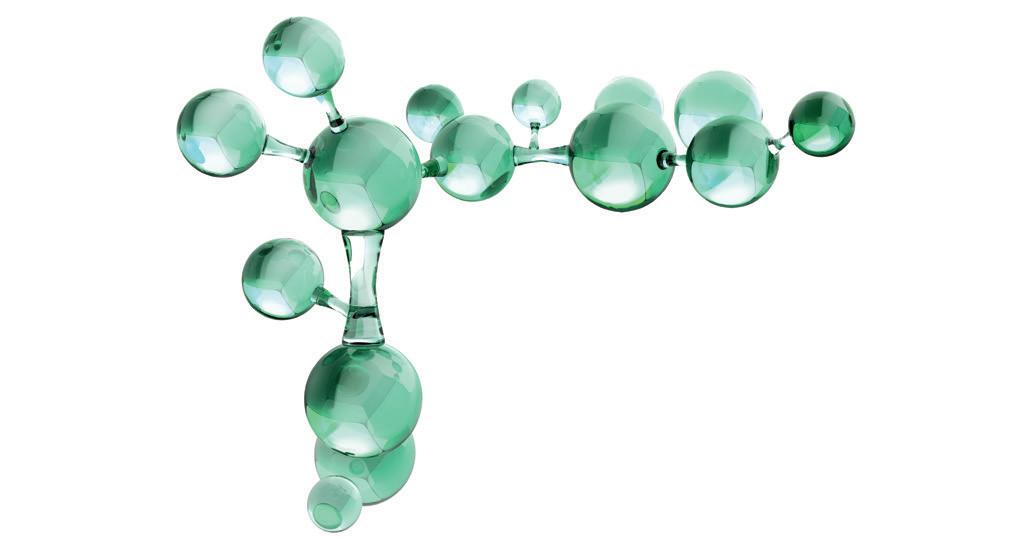
In this article, Zoë Davidson, Global Category Manager for the Ophthalmic franchise, Nemera, discusses the benefits of Novelia®, the company’s alternative to sterile filters for multidose eye droppers for preservative-free formulations.
The majority of eye drops today contain preservatives to maintain the sterility of eye drop formulations. The most used preservative is benzalkonium chloride (BAK), which has been known to damage the cornea with long-term use. Despite consistent data confirming its potential toxic effects, especially for chronic use, for example for glaucoma and dry eye disease, BAK is still used as the main preservative in eye drops.1
With the evolution of science and technology applied to ophthalmic treatments, there is an increasing need to further understand the eye, a complex organ that we all cherish and would like to protect and maintain in optimal health.2 As an industry we need to ensure that the patient is always put first.
There have been numerous efforts to improve the primary container closure system (CCS) of ophthalmic products. Multidose bottles have evolved to multidose preservative-free (MDPF) bottles.
To prevent the entry of bacteria into the bottle and/or to filter air, more than half of the bottles designed for MDPF eye drops on the market rely on a filtering system; 0.22 μm sterile mesh filters
being the industry standard. However, there is significant research that challenges their effectiveness.3 Due to their porous structure, bacterial filters do not provide a continuous barrier to contamination.
Nemera’s alternative to the use of sterile filters for multidose eye droppers for preservative-free formulations is a non-return valve system used in conjunction with a silicone membrane to process the returning air. The non-return valve ensures that no contaminated liquid can be reintroduced to the container after the drop has been dispensed, completely removing the need to filter the liquid. The intake of air into the dispenser takes place via a separate venting system with a silicone membrane called the PureFlow™. The silicone membrane is a solid, non-porous (unlike bacterial filters) material. It is homogenous and does not contain any holes, therefore its characteristics can be precisely engineered.
In a recent paper reviewing available containers for MDPF eye drops, Campolo, Crary and Shannon stated that Novelia® has “the largest amount of published information regarding the safety and sterility of these MDPF packages … and is able to withstand both the likely microbial challenges in real-world scenarios, as well as more significant and severe challenges which could occur.”4
Zoë Davidson Global Category Manager for the Ophthalmic Franchise
T: +33 7 86 09 52 48
E: zoe.davidson@nemera.net
Nemera
63 Avenue Tony Garnier 69007 Lyon France
www.nemera.net
“More than half of the bottles designed for MDPF eye drops on the market rely on a filtering system ... However, there is significant research that challenges their effectiveness.”3
In 2020, a study was conducted at Nemera’s R&D department, Insight Innovation Center, to understand these “challenges in real-world scenarios” encountered by dry eye and glaucoma patients with their current medication.5 A total of 16 participants were in the study included patients under treatment, ophthalmologists and nurse practitioners forming the healthcare provider (HCP) sample. Participants were asked to discuss their background and experience briefly as it related to managing their/their patients’ eye condition. This included symptoms, current therapies and treatment practices as well as relevant challenges or frustrations.
Patients commonly cited lack of control as a key challenge relating to eye drop administration. Both dry eye and glaucoma patients cited difficulty controlling the number of drops delivered as the most common complaint. Patients noted that more than one drop may come out at a time or even leaked before being squeezed. This becomes even more problematic when the bottle is almost empty, as patients must squeeze harder to get the drop(s) out and feel they have even less control.
While a minor annoyance to dry eye patients, this is more impactful for glaucoma patients who are unsure if they have received the proper dose and/or are concerned about their expensive medication running out prematurely. Nearly nine out of 10 glaucoma patients are unable to instil eye drops correctly and so an easy-to-use system could contribute to improving compliance.6
Patients and HCPs alike desire a bottle that allows control over the number of drops delivered, consistently delivering a single drop with each actuation.
Novelia’s PureFlow™ technology not only serves as a venting system but also controls medication flow (Figure 1). Nemera
has adapted the flow control within Novelia® that avoids multiple drop delivery into the eye and ensures that only one calibrated drop is dispensed at a time. Specifically, Nemera offers three different PureFlow™ versions, each tailored to formulations of differing viscosities, from highly fluid to highly viscous. In addition, five different valve sizes are available, each one delivering a different calibrated drop size. This allows Nemera’s team to customise the drop size depending on specific product requirements. This improved control leads to increased patient confidence (of accurate dosing), reduced frustration and medication waste.

“We Put Patients First” is not just a motto used by Nemera, but an attitude firmly ingrained in the company’s culture.
The earlier Nemera can include patients in the development phase to assess their behaviour with a new design, the better. Patients’ needs and constraints are generally identified when defining the product design brief and are included in Nemera’s quality process and documents such as product specification, design and user failure mode and effects analysis.
There is statistically significant variability in the force required to squeeze a drop from common glaucoma medications, and a representative sampling of clinic patients suggests that many likely struggle with the force requirements of several bottle designs.7
“I have arthritis in my hands, and all the other brands are so hard ... to squeeze out even one drop. This dispenser works with gentle pressure every time. I am so glad to have found them.”
“Nearly nine out of 10 glaucoma patients are unable to instil eye drops correctly and so an easy-to-use system could contribute to improving compliance.”
In 2015, Nemera had user tests carried out by an independent company. The panel of patients interviewed fell in to two main criteria – demographics (age, gender) and type of eye condition (glaucoma, dry eye, etc.). Patients were interviewed in their own homes in both the US and the UK. These tests concluded that 76% of patients interviewed preferred Novelia® over other similar devices on the market.8
Contributing factors to the preference for Novelia® included the intuitiveness of the screw-on cap and the associated reassurance and squeeze force required towards the product’s end-of-life. Novelia® required only 6% more pressure to squeeze the bottle at the end of the treatment compared with at the beginning, whereas for other MDPFs, the increase in required pressure was 35%. Patients, even those with dexterity issues and tremors/shaking, must be able to manipulate the delivery system effectively and administer a drop.
Products on the market using the Novelia® device rate consistently high among patients, with an average star rating on Amazon of 4.7/5 (across +4000 verified customer reviews). For example, one verified Amazon US customer, in her review of Systane™ Hydration PF (Figure 2), said: “I have arthritis in my hands, and all the other brands are so hard ... to squeeze out even one drop. This dispenser works with gentle pressure every time. I am so glad to have found them.”9
Patients also report concerns regarding unit doses. These include cost (as more packaging and eye drop solution per dose is required), waste and convenience, as it is easier to store a multi-use bottle in a preferred location than to ensure the patient has the correct number of unit dose pipettes with them every day.14 Handling difficulties have been noted with unit doses and their use by older patients, and inappropriate finger manipulation could be associated with an increased risk of contamination.10 Due in part to the rapidly ageing population, the number of people with glaucoma worldwide is expected to increase to over 111 million by 2040.11
In an analysis conducted by Nemera, comparing Novelia® multidose eyedropper for preservative-free formulations with unit dose packaging for a glaucoma-type regimen (one drop per eye twice per day) over one


month, there was eight times less plastic used, 25 times less drug waste and nine times less energy needed for transportation for Novelia®, compared with a unit dose.12
In 2022, Novelia® was successfully published on the Centre for Drug Evaluation (CDE) platform in China (Figure 3).13 The CDE performs regulatory
evaluation of new drugs and medical devices to assess if they can be brought to the Chinese market. Novelia®’s publication on the CDE platform ensures that Nemera’s delivery system can be referenced through the Drug Master File (DMF) number in Drug Product Applications in China. With this first milestone achieved, Nemera customers can now submit their documentation for the evaluation of their drug products with Novelia® delivery system.
Today, Novelia® has more than 250 references on the market for prescription and over-the-counter products in over 55 countries across Europe, Latin America, North America, Oceania, the Middle East and Asia Pacific.
A full range of low-density polyethylene (LDPE), bottles is available in 5, 7.5, 11 and 15 mL (Figure 4). Novelia® has been validated using both gamma and ethylene
“Today, Novelia® has more than 250 references on the market for prescription and over-the-counter products in over 55 countries across Europe, Latin America, North America, Oceania, the Middle East and Asia Pacific.”
oxide sterilisation. Offering two options for sterilisation allows Nemera to meet customers’ compatibility needs better. Nemera can also develop additional coloured Novelia® caps for specific demands. Finally, Nemera has developed two additional cap versions as part of the Novelia® offering to combat challenging formulations, thus expanding the scope of ophthalmic treatments served by the MDPF.
To serve customers in supporting patient needs, Nemera is once again extending its manufacturing capabilities, this time in the US, doubling its capacity to produce the Novelia® multidose eyedropper for preservative-free formulations (Figure 5). The new >9,000 square-foot ISO 7
cleanroom, will welcome high-speed assembly lines, and numerous injection moulds and injection moulding machines. In addition, this production capacity expansion in the US has created over 35 new direct and indirect positions at the Nemera Buffalo Grove, IL, plant.

Nemera offers a range of laboratory services for Novelia®, including testing of customers’ bulk formulation. Testing comprises usage simulation over two weeks, drop size analysis (variable depending on valve diameter), and flow control and squeeze force testing (beginning and near end of life). Analysis of the results allows Nemera to determine the best
Novelia® configuration for a particular customer formulation. Nemera can recommend the most suitable PureFlow™ control, bottle type and valve size to achieve the desired drop calibration.
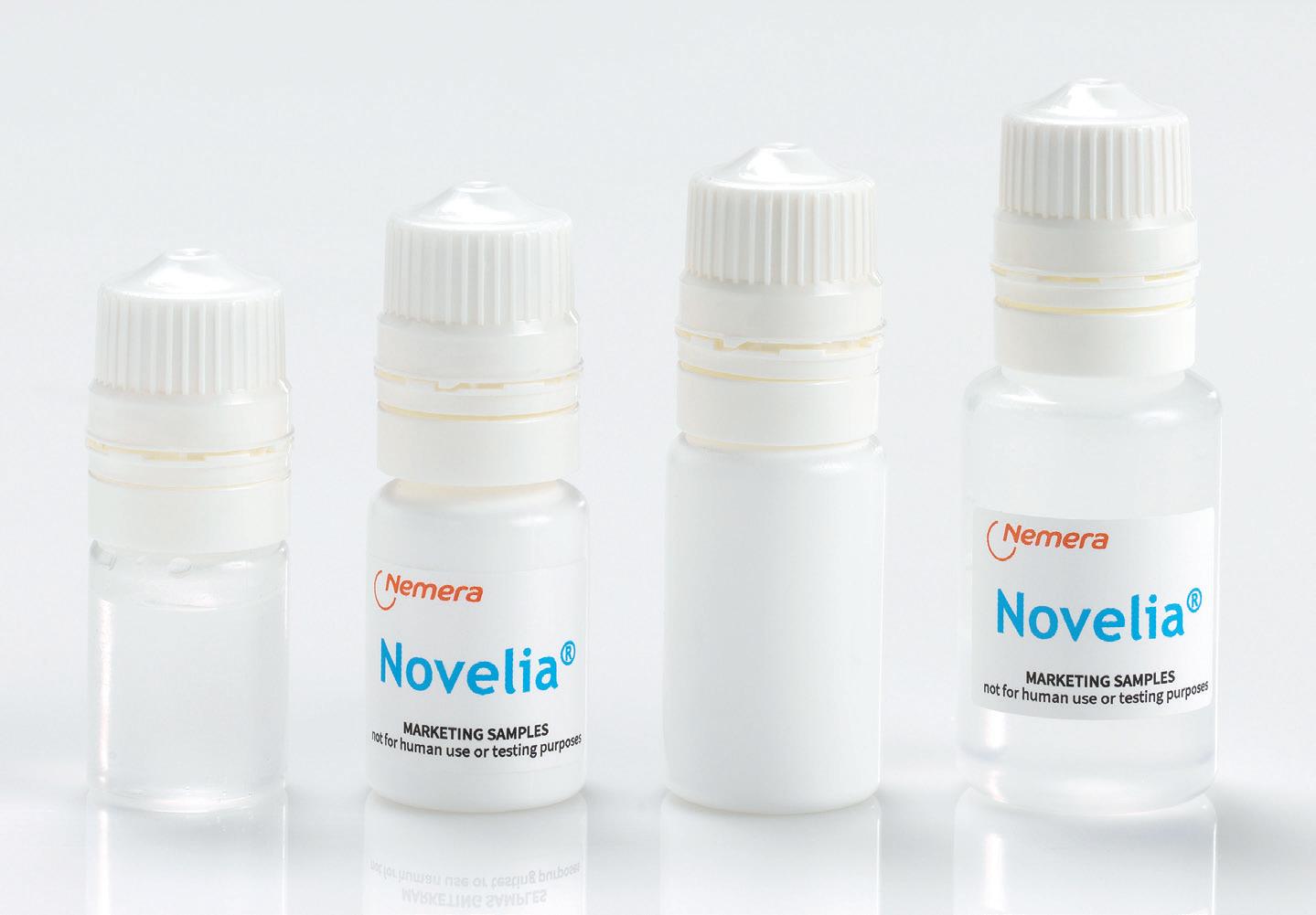
Nemera’s regulatory team is on hand to support customers with their submission filings, providing guidance on supportive documents for registration. Nemera can also assist customers in finding the right ready-to-go dossier available for private labelling certain molecules with the Novelia® delivery system. Nemera has a substantial list of partners, formulation licensors and fillers, all working in collaboration to bring to customers a finished drug-device combination product with Novelia®
While user-friendly containers are important, educational resources that teach patients how to apply their eye drops correctly have been found to mitigate issues with unintentional noncompliance.14 Nemera can support customers with product market launch, for example, in educating sales teams and HCPs on the delivery device, dedicated training and materials to assist in promotional material creation. Customisable patient guidance videos are also available in several languages to increase patient compliance around the world.
As a world-leading drug delivery device solutions provider, Nemera’s purpose of putting patients first enables it to design and manufacture devices that maximise treatment efficacy. Nemera is a holistic partner and helps its customers succeed in the sprint to market with their combination products. From early device strategy to state-of-the-art manufacturing, Nemera is committed to the highest quality standards. Agile and open-minded, Nemera works with its customers as colleagues. Together, they go the extra mile to fulfil their mission.
1. Gupta R et al, “Evaluating eyedrop instillation technique in glaucoma patients”. J Glaucoma, 2012, Vol 21(3), pp 189–192
2. Seshadri N, Uday B, “Ophthalmic Product Development, From Bench to Bedside”. Book, Springer, 2021.
3. Hasegawa H et al, “Membrane filter (pore size, 0.22-0.45 μm; thickness, 150 μm) passing-through activity of

Pseudomonas aeruginosa and other bacterial species with indigenous infiltration ability”. FEMS Microbiol Lett, 2003, Vol 223(1), pp 41–46.
4. Campolo A, Crary M, Shannon P, “A Review of the Containers Available for Multi-Dose PreservativeFree Eye Drops”. Biomed J Sci & Tech Res, 2022, Vol 45 (1).
5. “User study performed by Insight Innovation Centre”. ICH report, Chicago, USA (2020).

6. Gupta R et al, “Evaluating eyedrop instillation technique in glaucoma patients”. J Glaucoma, 2012, Vol 21(3), pp 189–192.



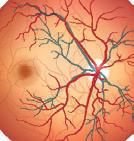

7. Moore DB et al, “Squeeze Me if You Can: Variability in Force Requirements to Extract a Drop from Common Glaucoma Bottles”. J Glaucoma, 2016 Vol 25(9), pp 780–784.

8. “User study performed for Nemera by GfK to understand the Novelia® market opportunities versus competitors (Aptar OSD system)”. GfK report, Paris, France, (2015).
9. US Customer Review of Systane™
Hydration PF, Company Web Page, Amazon, November 20, 2022. (https://www.amazon.com/productreviews/B0857XD9V6, accessed February 2023.)
10. Bagnis A et al, “Antiglaucoma drugs: The role of preservative-free formulations”. Saudi J Ophthalmol, 2011, Vol 25(4), pp 389–394.

11. Tham Y et al, “Global Prevalence of Glaucoma and Projections of Glaucoma Burden Through 2040: A systematic review and metaanalysis”. Ophthalmology, 2014, Vol 121(11), pp 2081–2090.

12. “Comparison analysis conducted by Nemera comparing Novelia® multidose eyedropper for preservative free formulations with unit dose packaging,” Internal Research, Nemera, 2020.
13. “Novelia®, published on CDE (Centre for Drug Evaluation) platform in China!” Company Web Page, Nemera, October 12, 2022.
14. Davis SA et al, “A randomized controlled trial of an online educational video intervention to improve glaucoma eye drop technique”. Patient Educ Couns, 2019, Vol 102(5), pp 937–943.

Zoë Davidson has held the position of Global Category Marketing Manager for Nemera’s ophthalmic franchise since 2019. In this role, Mrs Davidson is responsible for the strategy management of Nemera’s flagship own-IP multidose eyedropper for preservative-free formulations, Novelia®. With over six years’ experience in the pharmaceutical and medical device industry, Mrs Davidson is motivated about gaining insights into patients’ needs and wants within the ophthalmic space. Hailing from Glasgow, Scotland, Mrs Davidson now calls Lyon, France home, where she lives with her husband and their two young sons.

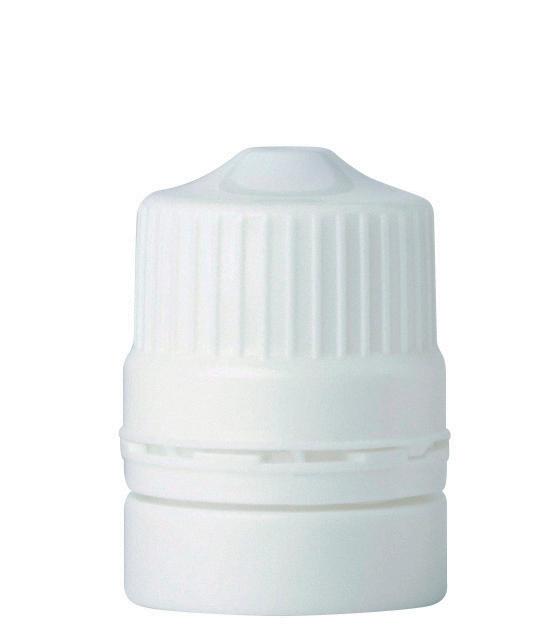

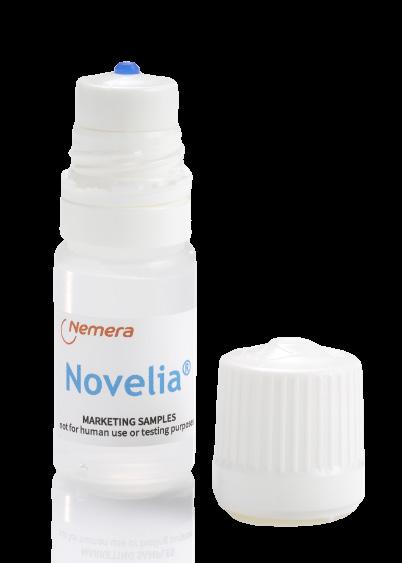

The ophthalmic drug market is expected to experience significant growth over the coming years due to the increasing prevalence of ophthalmic disorders. This is primarily attributable to factors such as increased life expectancy leading to ageing populations, increased air pollution and the rise in the number of patients diagnosed with diabetes. According to the WHO, approximately 2.2 billion people suffer from some form of visual impairment worldwide.1 Several market research reports predict a compound annual growth rate (CAGR) for the ophthalmic market of almost 8% from 2022 to 2030, which will reach around US$68.9 billion (£57.3 billion) by 2030.2
Topically delivered eye drops are one of the most popular dosage forms for treating ophthalmic diseases. With a revenue share of around 40%, North America dominates the global market. According to available data, more than three million Americans are affected by glaucoma and only half of those are aware that they are affected. The National Eye Institute predicts that between 16 million and 49 million Americans suffer from dry eye symptoms, which accounts for 5%–15% of the population.3
There are several eye drop medications available to treat glaucoma, dry eye and other ocular diseases, with a multitude of different delivery technologies. Single-
dose vials are designed to dispense a single specified amount of medicine, and then be discarded. Of course, this leads to a lot of packaging waste. Furthermore, due to an unclean tear-off edge, there is a risk of injury to the eye during application.
Three-piece-droppers are conventional multidose bottles for preserved medications. Their squeeze mechanism can lead to an overdosing if the patient squeezes too hard and, towards the end, the force required to actuate them becomes higher and higher. Moreover, unlike single-dose vials, they are not suitable for use with preservativefree medications. Regulatory bodies recommend the use of preservative-free delivery technologies to protect the ocular surfaces from any side-effects that can be caused by common preservatives, such as benzalkonium chloride. Preservatives are known to be associated with toxic side effects, such as dry eye symptoms and trabecular meshwork degeneration.
This recommendation by regulatory authorities has led ophthalmic manufacturers to a groundbreaking trend – switching their eye drops to use a preservative-free multidose (PFMD) delivery technology. One of the first PFMD ophthalmic drugs in the US has been Allergan’s (Dublin, Ireland) blockbuster product Restasis® (cyclosporine) for the
Rouven Kraus Head of Sales
T: +49 6146 6030
E: sales@aeropump.de
Aero Pump GmbH
Dr-Ruben-Rausing-Straße 5 65239 Hochheim Germany
www.aeropump.de/en/
treatment of chronic dry eye. While most eye drop-based medications are still offered in a preserved form, there is now a significant trend towards the use of preservative-free delivery platforms.
Industry and healthcare experts in the US are taking Europe as a pioneering example of this change. There, the switch to preservative-free medications took place more than two decades ago. Brands such as Ursapharm’s (Saarbrücken, Germany) Hylo-COMOD® (sodium hyaluronate) eye drops for the treatment of dry eye or Bausch + Lomb’s (Laval, Canada) Vizilatan (latanoprost) for glaucoma have been successfully launched on the market. Nowadays the majority of multidose eye drops in Europe come in preservative-free packaging. Looking at investigational new drug applications (INDs) registered at the US FDA, most new product developments in the US now also consider a preservative-free delivery technology for their ophthalmic drug product.

The FDA has defined regulations for the development of drug-device combination products, which are applicable to most eye drop medications (Figure 1). A combination product is a product composed of any combination of a drug and another constituent part – the device – which can come prefilled by the manufacturer or simply co-packaged in the same box.4
Being classified as a combination product challenges device manufacturers to fulfil the requirements outlined in 21 CFR 820.30 for design controls. As such, manufacturers
of the device part of the combination product must record a device history file –a compilation of documentation providing evidence that the design was developed in accordance with the approved design plan and its requirements. Due to these new regulations, it is crucial for the applicant of the finished product to select a device manufacturer that can support them through the entire regulatory pathway.
Aero Pump offers device manufacturing services with a full regulatory understanding for its well-known 3K® system – a pumpdriven delivery technology that applies a single metered drop per activation. Custom-fit regulatory packages support the application during the individual stages of the submission process.
Aero Pump’s 3K pump eyedropper is well-established and has been on the market since its first product launch in 2006. It is the only eyedropper based on a purely mechanic pump technology that offers a metered dose. Special germ-reducing components inside the 3K system ensure

“This recommendation by regulatory authorities has led ophthalmic manufacturers to a groundbreaking trend – switching their eye drops to use a PFMD delivery technology.”
“Aero Pump offers device manufacturing services with a full regulatory understanding for its well-known 3K system.”Figure 1: New regulations are making it crucial for applicants to select a device manufacturer with regulatory knowledge.
the microbiological safety of the device. The 3K pump is used in numerous approved over-the-counter and prescription drug products.
Various patient-friendly actuation aids enable the convenient application of a drop into the eye. Aero Pump’s pharmaceutical customers can choose their preferred finger sleeve design, which can then be customised to meet the needs of the end user (Figure 2). Furthermore, the 3K system can be used with plastic or glass containers in various fill sizes, which is a particular advantage when attempting to reduce the interaction between the container and the product.
The 3K system delivers an accurate dose over the whole lifecycle of the product, with one metered drop per stroke. The actuation force of Aero Pump’s ophthalmic multidose system is stable and independent of the residual liquid inside the container. The device will be CE-marked to accelerate the approval process of the drug product, and Aero Pump offers comprehensive support for a successful regulatory submission process.
Aero Pump GmbH is a leading manufacturer of high-precision application systems for the pharmaceutical and healthcare industry, focused on innovation, multifunctionality and contemporary design. Its spray pumps and dropper systems are widely established in markets worldwide, primarily in the ophthalmic, respiratory and dermal fields, and are suitable for preserved and preservative-free overthe-counter and prescription drugs. The company has extensive knowledge in supporting pharmaceutical customers with custom-fit regulatory files for a successful submission.
1. “Blindness and vision impairment”. WHO, Oct 2022.
2. “Ophthalmic Drugs Market –Global Industry Analysis, Size, Share, Growth, Trends, Regional Outlook, and Forecast 2022-2030”. Precedence Research, Nov 2022.
3. “Eye-Drop And Lubricants Market By Product Type, By Application, By Geography - Global Opportunity Analysis & Industry Forecast, 2022-2027”. IndustryARC, 2022.
4. “Regulation (EU) 2017/745 Article 117: Drug-device combination products application process”. EMA, Apr 2017.
Rouven Kraus has more than 10 years of experience in the ophthalmic drug market. He started his career in sales for a domestic iron foundry in Mainz, Germany, and joined Aero Pump in 2012 to augment the sales of their drug delivery device portfolio. In his role he manages global sales and the company’s strategic approach to new ophthalmic developments and delivery technologies. Quote
Ensuring Quality, Safety, Suitability & Regulatory Compliance for Drugs, Biologics and Med Devices Philadelphia, PA


Conference Highlights Include:
• Designing and Improving Risk-Based Assessment of E&L Data for Drugs, Biologics, and Medical Devices
• Implementing ISO 10993-17 & ISO 10993-18 Standards
• AETs and Response Factor Variation for E/L Studies
Speakers Include:
• Dennis Jenke, Triad Scientific
• Nicole Soucy, Boston Scientific
• Ping Wang, Janssen R&D
Register online at: www.pharmaedresources.com For further info, contact Kim: (217) 721-5774, or email us: khubbard@pharmaedresources.com 32 www.ondrugdelivery.com Copyright © 2023 Frederick Furness Publishing Ltd


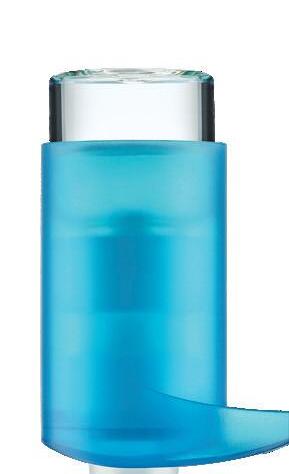

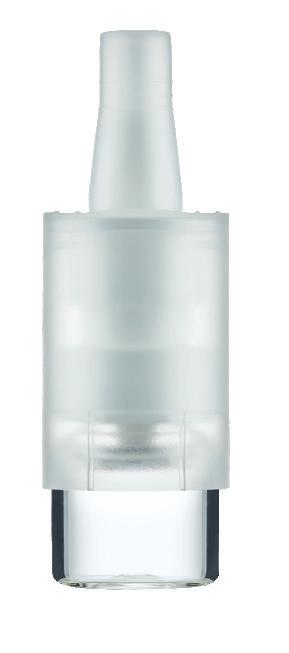


Here, Harsh Patel, PhD, Senior Scientist, Cyonna Holmes, PhD, Global Ophthalmology Strategy Lead, and Brian Wilson, PhD, New Business Development Partner, all at Celanese, discuss how the company’s VitalDose® EVA drug delivery platform can help reduce intraocular pressure by creating a desired therapeutic release profile.
Glaucoma is a prevalent disease among older populations and the global drug market is forecast to reach around US$8.8 billion (£7.3 billion) in 2025 and around $11 billion by 2030.1 Market growth drivers include an increase in the ageing population and the emergence of new therapeutics. Although therapeutics exist to treat glaucoma, there remains an unmet need for improving treatment efficacy through increased patient adherence and drug bioavailability.
Topical eye drops are a common first-line treatment in glaucoma. However, up to 60% of patients do not realise the full efficacy of their medications due to compliance and adherence issues, regimen complexity and, often, an initial asymptomatic presentation that results in improper dosing.2 Bioavailability, drug elimination, rapid clearance and limited absorption at target sites can also diminish therapeutic efficacy.
Treatment goals focus on reduction of intraocular pressure (IOP) by 20%–50% to provide IOP control over the lifetime of this chronic condition.3 To address this challenge, newer treatments have emerged using novel mechanisms of action (MoA) and innovative drug delivery systems and
devices. While novel MoAs focus on new IOP-lowering targets, most drug delivery systems for glaucoma aim to improve pressure management through sustained, longer-acting treatments. These patientcentric delivery systems have the potential to address common unmet needs and reduce the need for frequent dosing.
Innovative, long-acting delivery options are being developed to address current treatment limitations and different routes of administration. Ocular inserts, intracameral depots and punctal plugs represent the wide range of potential routes for sustained delivery approaches. Therapeutic release via these routes varies in duration from three months to three years and provides continuous delivery for improved IOP management.
Dr Harsh Patel
Senior Scientist, Pharma & Medical
T: +1 859 372 3256
E: harsh.patel@celanese.com
Dr Cyonna Holmes
Global Strategy Lead for Ophthalmology, Rare Diseases and RNA Therapeutics
E: cyonna.holmes@celanese.com
Dr Brian Wilson
New Business Development, Pharma & Medical
T: +1 616 286 7457
E: brian2.wilson@celanese.com
Celanese Corporation
222 West Las Colinas Boulevard Suite 900N Irving Texas 75039 United States
healthcare.celanese.com
“Most drug delivery systems for glaucoma aim to improve pressure management through sustained, longer-acting treatments.”
Intracameral depots are an effective route of administration as demonstrated by Allergan’s (Dublin, Ireland) Durysta® (bimatoprost intracameral implant), the first long-acting glaucoma implant treatment to gain US FDA approval. Pipeline approaches being evaluated in trials include Ocular Therapeutix’s (MA, US) OTX-TIC (travoprost intracameral implant) and Glaukos’s (CA, US) iDose TR (travoprost intraocular implant) depots that both offer a sustained release of travoprost. These are localised dose forms placed near the site of action and are a route to consistent delivery and control of IOP.
Beyond the dose forms in development, there is an opportunity to pair ocular drug delivery with existing devices for IOP control using mechanical redirection of fluid flow. By combining these tubes, plates and shunts with a drug-eluting element, improved outcomes can be achieved with a combination device. Pairing these wellknown and frequently used devices with a drug delivery mechanism would allow
the mechanical and therapeutic modes of action to work in tandem. The addition of drug elution to these devices may also help reduce inflammation that is often associated with the implantation of these devices. A wide range of drugs, from antibiotics to anti-inflammatories to IOP-lowering agents, can be incorporated into these devices (Figure 1).
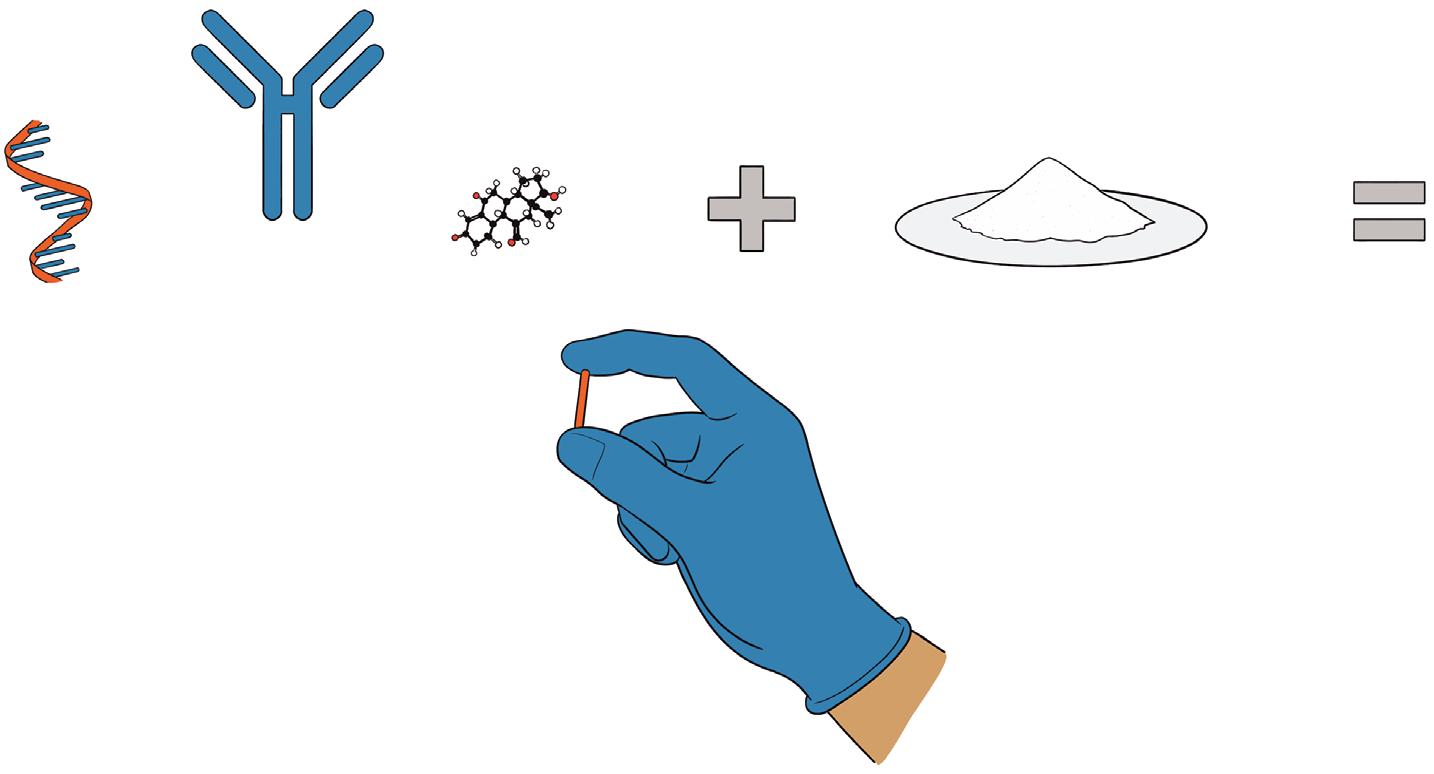
Since these devices are often made of durable polymers, non-erodible polymers are a natural choice in their redesign. The strength of durable polymers, such as Celanese’s VitalDose® EVA, in ocular-based drug delivery strategies include:
• High drug loading without compromising mechanical integrity or long-term release kinetics
• Drug-release profiles of 12 months or greater for small molecule therapeutics
• Minimal risk of drug molecule instability due to the absence of polymer degradants.
The size of most drainage devices offers the potential for a large loading of one or multiple drugs to be delivered over a period of time. These parts can be made via extrusion and moulding, approaches that are typically used in the fabrication of the original device parts. Films, rods and discs represent a small sampling of the form factors that are possible for the drug delivery component (Figure 2).
These delivery geometries can work to replace existing segments or entire parts within a medical device to allow for a dual-action approach. IOP-lowering medications can be released from VitalDose® EVA and the loading percentage can be tuned to achieve the desired release profile. Additionally, different form factors (film, rod, etc.) have demonstrated sustained release that further highlights adaptability to current medical devices.

Celanese Corporation is a global chemical leader in the production of differentiated chemistry solutions and speciality materials used in most major industries and consumer applications. The company’s businesses use the full breadth of Celanese’s global chemistry, technology and commercial expertise to create value for its customers, employees, shareholders and the corporation. Celanese partners with its customers to address their most critical business needs and strives to make a positive impact on communities and the world through The Celanese Foundation. Based in Dallas (TX, US), Celanese employs over 13,000 employees worldwide and had 2021 net sales of $8.5 billion.
“By combining these tubes, plates and shunts with a drug-eluting element, improved outcomes can be achieved with a combination device.”*Implant not to scale
For the pharmaceutical industry, Celanese offers the VitalDose® EVA drug delivery platform, providing controlled drug release through implants and inserts. Compared with traditional dose forms, the VitalDose® platform reduces treatment burden, addresses patient adherence issues and improves bioavailability. The company partners with clients to enable innovative drug delivery of small molecules, biologics and RNA within the desired release profile. With decades of experience in medical and pharmaceutical applications, Celanese seeks to improve product development and elevate patient care.


1. “Ophthalmology Drugs Global Market Opportunities and Strategies to 2030: COVID 19 Impact and Recovery”. The Business Research Company, May 2020.
2. Zaharia A et al, “Adherence to Therapy in Glaucoma Treatment – A Review”. J Pers Med, 2022, Vol 12(4), p 514.
3. Rahic O et al, “Novel Drug Delivery Systems Fighting Glaucoma: Formulation Obstacles and Solutions”. Pharmaceutics, 2021, Vol 13(1), p 28.
Harsh Patel earned his PhD in Biomedical Engineering from the University of Alabama (Birmingham, AL, US) and his MS in Bioengineering from the University of Pittsburgh (Pittsburgh, PA, US). He has extensive technical experience in parenteral drug delivery across multiple polymers. At Celanese, Dr Patel serves as a Senior Scientist for Pharma & Medical and holds patents and has numerous published articles in peer-reviewed journals.

Cyonna Holmes earned her PhD in Biomedical Engineering from the University of Texas Southwestern Medical Center (Dallas, TX, US) and her BS in Bioengineering from Stanford University (Stanford, CA, US). At Celanese, Dr Holmes serves as Global Strategy Lead for Ophthalmology, Rare Diseases and RNA Therapeutics. She has experience in the areas of drug delivery, lifecycle management strategy, new product development and market entry strategy. She has published articles in peer-reviewed journals.

Brian Wilson earned his PhD in Biochemistry from the University of Notre Dame (IN, US). He has 11 years of API experience in the areas of formulation development, drug delivery and new product development. At Celanese, Dr Wilson serves as a new business development partner for the pharma and medical businesses. He holds patents and has numerous published articles in peer-reviewed journals.




Our VitalDose® EVA technology is a drug delivery platform providing controlled release through implant and insert dosage forms. The VitalDose® EVA platform has proven biocompatibility and achieves >6 months release of mAbs, peptides, small molecules, and fixed dose combination therapies. We partner with you to enable innovation within your desired delivery profile.
The Celanese Development & Feasibility Lab offers the following support:

• Material selection
• Formulation and R&D prototype development
Collaborate with us
• Drug release testing

• Tech transfer
Email: Healthcare@Celanese.com
Website: www.vitaldose.com
In this article, Andrea Allmendinger, PhD, Chief Scientific Officer, and HannsChristian Mahler, PhD, Chief Enablement Officer, both at ten23 health, highlight the technical challenges of intravitreal administration and considerations from the ophthalmologist’s and patient’s perspectives.
Severe retinal disorders such as diabetic retinopathy and age-related macular degeneration can now be treated with biological drugs, such as anti-vascular endothelial growth factor (anti-VEGF). Such products need to be administered into the vitreous humour in the back of the eye.
In previous articles, we discussed that ophthalmic products require a high level of process knowledge and state-ofthe-art manufacturing technologies and expertise to maximise safety, meet stringent regulatory requirements and minimise cost of goods.1 We also highlighted new regulatory and quality requirements for intravitreal (IVT) applications, and reflected on technical challenges during drug product technical development and manufacturing.2
In this article, we will highlight technical challenges associated with IVT product use and administration, and include considerations from both the ophthalmologist’s point-of-view (e.g. selection of needle size, small injection volumes) as well as from the patient’s perspective.
Dosage forms intended for IVT administration are typically supplied in vials or in a ready-to-use prefilled syringe (PFS) configuration made of glass or a cyclic olefin polymer or copolymer (COP or COC, respectively). Prefilled primary packaging options circumvent the need for additional aseptic preparation steps, such as withdrawal of the drug product solution from the primary packaging container (vial), which minimises the risk of contamination, and hence benefits patient safety.
However, in contrast to many other parenterally used syringes, which are typically supplied with a staked-in needle, IVT prefilled dosage forms are usually supplied without an attached needle but with a Luer-lock connection. The reason is
Dr Andrea Allmendinger Chief Scientific Officer
E: andrea.allmendinger@ten23.health
Prof Hanns-Christian Mahler Chief Enablement Officer
E:
hanns-christian.mahler@ten23.healthten23 health AG
Mattenstrasse 22
4058 Basel Switzerland
www.ten23.health
“Prefilled primary packaging options circumvent the need for additional aseptic preparation steps.”
that many ophthalmologists want to select their own needle of preference and may choose between 31G (gauge), 30G and, in very rare cases, even 27G or bigger.
From a drug product technical development perspective, a higher gauge number represents a smaller needle inner diameter and leads to higher injection forces compared with a smaller gauge. According to Hagen-Poiseuille’s law, injection forces depend on the inner needle diameter by the power of four. It should be noted that only outer needle diameter is harmonised with the “gauge” terminology, but inner needle diameter is not. Hence, it is likely that needles from different suppliers that are both nominal “30G” needles, behave very differently in terms of injection force and/or injection time and hence usability and administrability.
Besides the needle inner diameter, injection forces during IVT administration are also influenced by syringe diameter, needle length, injection speed and formulation viscosity. The latter should ideally be minimised during formulation development. However, viscosity is also dependent on temperature. This implies that not only should injection forces be studied during development at intended use (room) temperature, but also at intended storage conditions, typically between 2°C and 8°C, in case the drug product has not been equilibrated adequately, in order to ensure adequate injection forces. Maximum and target injection forces need to be determined based on user preference, e.g. in usability studies. However, they should typically not be much higher than 10 N. Importantly, viscosity is not just a value at a given temperature. Protein
formulations may have a very variable viscosity and such formulations may exhibit Newtonian or Non-Newtonian flow behaviour, which significantly influences injection forces.3
Injection volumes for IVT application typically range between 25 and 50 μL. However, injection volumes as high as 100 μL have been reported, although little is known about the upper limit of injectable volume to the back of the eye.4 The lower limit of injected volume is usually defined by the precision of injection devices, which is currently around 10 μL for conventional syringes used, depending on graduation marks and proficiency of the target users.
From a technical perspective, filling small volumes into primary packaging containers during fill-finish operations is challenging,
both from a filling accuracy perspective as well as from a visual inspection point of view (Figure 1).
IVT dosage forms are, in most cases, overfilled, hence requiring down-dosing to the desired injection volume indicated by a graduation mark according to the instructions for use.
As an example, syringes filled with 100 μL target fill volume would, for example, need to be down-dosed to a target injection volume of 50 μL, which, on the one hand, provides a user challenge in terms of precision of the down-dosing, but also generates significant product waste, adversely contributing to overall cost of goods. To ensure dosing accuracy, syringes intended for IVT injection must be appropriately characterised (Figure 2).5,6 In addition, the absence of an air bubble in the syringe is highly desired from a user perspective as down-dosing may be considerably more difficult.
ten23 health is capable of precisely filling very small volumes for IVT applications at the highest filling accuracy in the absence of an air bubble while minimising product losses.


“ten23 health is capable of precisely filling very small volumes for IVT applications at the highest filling accuracy in the absence of an air bubble while minimising product losses.”Figure 1: Operator at the filling line in Visp, Switzerland.
Injections into the vitreous humour require the highest quality standards to prevent microbiological infections during treatment. Sterility of the drug product is a prerequisite for any parenteral preparation, but considerations for IVT preparations often exceed these standards. Many ophthalmologists ask for a “sterilised syringe” (i.e. sterilisation of the outside of the syringe), which is currently not a formal regulatory requirement. As a result, filled PFS for IVT use are typically decontaminated on the outside in their secondary packaging. This is especially interesting given that many ophthalmologists often do not perform IVT injections in a sterile environment, meaning microbiological contamination after opening of the secondary packaging may occur.
Outside decontamination can be performed by gas sterilisation, for example, by vaporised hydrogen peroxide, ethylene oxide, peracetic acid or nitrogen dioxide. From a technical perspective, gas sterilisation of a filled drug product is challenging as the product quality needs to be maintained. The secondary packaging has to ensure gas permeability.
For pharmaceutical manufacturers, it is important to define target criteria for such outside decontamination processes, including: (a) bioburden before the gas sterilisation process and overall considerations on how to minimise and limit these (low bioburden handling from point of fill to point of secondary packaging); (b) temperature and hold times during processing; (c) target bioburden after the process (is the target to achieve low bioburden or sterility?); and (d) acceptance criteria for any observed quality changes of the product. As an example, polymer syringes, as well as rubber stoppers, are typically highly gas permeable. Hence, it must be assumed that gas may also enter the product solution and may lead to product alterations, such as modifications of the active ingredient, e.g. protein aggregates, adducts or fragments. Highend mass spectrometry is typically required to monitor such product alterations, and typical specification tests may not detect such alterations of the protein. In addition, the gas and process conditions may also lead to alterations of the primary packaging container itself. However, pharmaceutical manufacturers and regulatory authorities should probably carefully assess whether
performance of outside decontamination of the syringe in its secondary packaging – which is likely to be contaminated after opening by the user – outweighs any product alteration triggered by the decontamination process.
Besides microbiological product quality, endotoxin levels in the final product are key, especially for IVT preparations. There are many great publications about the effect and no-observed-adverse-effect levels (NOAEL) of endotoxins after IVT injection into preclinical test species. The NOAEL in rabbits and monkeys has been reported to be as low as 0.01 EU/mL.7,8
These NOAEL are even lower than the levels discussed by the US FDA Guidance for Industry (2015).9 Thus, it is expected that regulatory requirements for endotoxins in IVT preparations are likely to be tightened, given the potential toxicity in the eye. As a result, endotoxin contamination in the API, excipients, as well as primary packaging must be carefully assessed for IVT preparations. Considering that many PFS for IVT injections are “ready to use”, a key focus needs to be on setting acceptable limits for endotoxins (“specifications”) in such container closure systems and on how these relate to a final drug product specification of “NMT (not more than) 0.01 EU/mL”.
Formulations for IVT applications are developed to best stabilise the active ingredient during manufacturing, storage and transport of the drug product, while ensuring pharmacopoeial and regulatory compliance and physiological tolerance in addition to adequate viscosity. However, the choice of excipients for parenteral preparations is quite limited as they must be tolerated and safe, i.e. non-toxic and non-immunogenic at the intended dose, and approved for parenteral use.
In addition, not all excipients approved for parenteral use are Generally Recognized As Safe (GRAS) for IVT use. For example, methionine acting as a stabiliser or antioxidant in many parenteral formulations has not previously been used for IVT injections, so it should not be used in formulations for IVT administration without very careful and detailed safety assessments. In addition, further consideration should be given to immunogenicity in the eye. Not only excipients, but also drug product impurities, need to be carefully controlled to avoid exacerbating immune responses or even non-drug-related toxicities.10 In addition, excipients and APIs in IVT formulations may also interact with components of the vitreous humour in vivo 11,12
Particulate matter is regulated for any parenteral preparation. Particulate matter is specifically regulated for IVT preparations, although no controlled preclinical studies have been conducted that relate to the medical relevance of particulates after IVT injection, and there is no other clear clinical evidence. A major concern is if such particulates impact patients’ vision, and particle properties, for example, if floating or if to dissolve in the vitreous humour, need to be considered.13 Requirements for IVT preparations in the European Pharmacopoeia (Ph Eur) are aligned with the requirements of other parenteral preparations (0520). These require products to be “practically free of particles” (Visible Particles, Ph Eur 2.9.20, further discussed in the recommendation chapter 5.17.2.), and the following requirements for sub-visible particulates (Ph Eur 2.9.19) with a maximum of 6000 particles/container for particle sizes ≥10 μm and a maximum of 600 particles/container for particles ≥25 μm. This is significantly different from the US Pharmacopeia (USP), chapter <789>, which suggests significantly tighter limits for IVT preparations, e.g. not more than (NMT) 50 particles mL for particle sizes ≥10 μm and NMT 5 particles/mL for particles ≥25 μm (when using light obscuration testing). This is especially interesting, given that particles may originate from the formulation or primary packaging itself.
Glass syringes typically used for IVT injections are normally siliconised to ensure lubrication and functionality for the user. Hence, unsurprisingly, silicone oil droplets
“Formulation excipients, as well as drug product impurities, need to be carefully controlled to avoid exacerbating immune responses or even non-drug-related toxicities.”
are likely to be detected as (sub-visible and possibly visible) particles in the final drug product after (simulated) injection. The amount of silicone oil used for lubrication, along with the formulation and the storage time of the PFS, may impact the level of silicone detected after (simulated) injection. The measurement of such silicone droplets as particulates is a confounding factor (false positive) during the analysis of particulate matter (Figure 3). Flow imaging analysis and other morphological characterisation tools can easily support the identification of silicone droplets versus any actual particulate contamination.
Given the very low acceptance criteria suggested by USP <789>, many companies try to avoid such analytical findings and hence want to avoid siliconised syringes, especially for IVT use, and evaluate or choose nonsiliconised primary containers (syringes).
To note, although occasionally discussed as of concern, minute amounts of silicone droplets are typically not considered as being of any significant medical concern.14 Interestingly, silicone is also used for optical surgery, where approximately 2–3 mL silicone is used in the eye.15
Dosing Frequency
From a patient’s perspective, IVT injections bring hope for the treatment of numerous severe retinal disorders, but frequent injections – in some cases weekly or every other week – are also a burden. To increase patient convenience and minimise any risks related to the number of treatments, pharmaceutical manufacturers should be motivated to explore products that offer less frequent injection.
A possible approach relates to sustained releasee, which can be achieved by (a) a modified formulation, (b) alterations to
the API (for example by conjugation) or (c) by use of a medical device. From a technical development perspective, sustained release can be highly challenging and requires extensive product characterisation studies to succeed. Very good overviews of sustained-release options and associated challenges are provided elsewhere.16,17
IVT preparations present various pharmaceutical and user challenges. ten23 health’s development and aseptic manufacturing services can appropriately and proactively address the needs and complexities associated with IVT and other parenteral preparations.

As a CMDO, ten23 health is appropriately positioned to anticipate and overcome the challenges that relate to sterile drug products, especially for subcutaneous and IVT use. The company offers integrated development of formulation services, analytical development and product characterisation, device selection and testing, drug product process design, product characterisation and failure mode assessments with its high-end capabilities in particulate characterisation and injection force and container closure integrity testing. ten23 health also provides fill and finish (sterile manufacturing) of complex and high-precision containers
at its facility in Visp, Switzerland, including syringes, vials and cartridges, for both glass and novel containers.
1. Glöckler L, Delauney C, “State-ofthe-Art Solutions for Ophthalmic Sterile Drug Product Manufacturing.” ONdrugDelivery, Issue 118 (Apr 2021), pp 8–10.
2. Allmendinger A, Mahler H-C, “How ten23 health is Meeting Developmental Challenges for Intravitreal Products”. ONdrugDelivery, Issue 130 (Mar 2022), pp 43–48.
3. Allmendinger A et al, “Rheological characterization and injection forces of concentrated protein formulations: An alternative predictive model for non-Newtonian solutions”. Eur J Pharm Biopharm, 2014, Vol 87(2), pp 318–328.
4. Parenky AC, “Container Closure and Delivery Considerations for Intravitreal Drug Administration”. AAPS PharmSciTech, 2021, Vol 22(3), p 100.
5. Peláez S et al, “Characterization of Polymeric Syringes Used for Intravitreal Injection”. J Pharm Sci, 2020, Vol 109(9), pp 2812–2818.
6. Weinmann C et al, “Role of Formulation Parameters on Intravitreal Dosing Accuracy Using 1 mL Hypodermic Syringes”. Pharm Res, 2020, Vol 37(10), p 190.
7. Bantseev V et al, “Determination
“IVT injections bring hope for the treatment of numerous severe retinal disorders, but frequent injections – in some cases weekly or every other week – are also a burden for the patient.”
of a No-Observable Effect Level for Endotoxin Following a Single Intravitreal Administration to Dutch Belted Rabbits”. Invest Ophthalmol Vis Sci, 2017, Vol 58(3), pp 1545–1552.
8. Bantseev V et al, “Determination of a No Observable Effect Level for Endotoxin Following a Single Intravitreal Administration to Cynomolgus Monkeys”. J Ocul Pharmacol Ther, 2019, Vol 35(4), pp 245–253.
9. “Guidance for Industry and Food and Drug Administration Staff. Endotoxin Testing Recommendations for Single-Use Intraocular Ophthalmic Devices”. US FDA, Aug 2015.


10. Wakshull E et al, “Advancements in understanding immunogenicity of biotherapeutics in the intraocular space”. AAPS J, 2017, Vol 19(6), pp 1656–1668.
11. Patel S et al, “Evaluation of protein drug stability with vitreous humor in a novel ex-vivo intraocular model”. Eur J Pharm Biopharm, 2015, Vol 95(Pt B), pp 407–417.
12. Patel S et al, “Prediction of intraocular antibody drug stability using ex-vivo ocular model”. Eu J Pharm Biopharm, 2017, 112, pp 177–186.
13. Patel S et al, “Evaluation of protein drug performance with vitreous humor in a novel ex-vivo intraocular model”. iOVS, 2015, Vol 56(7), p 258.
14. Antoun J et al, “Vitreoretinal surgery with silicone oil tamponade in primary uncomplicated rhegmatogenous retinal detachment”. Retina, 2016, Vol 36(10), pp 1906–1912.
15. Bakri SJ et al, “Intravitreal silicon oil usage after intravitreal drug injection”. Retina, 2008, Vol 28, pp 996–1001.
16. Hughes P et al, “Intraocular delivery considerations of ocular biologic products and key preclinical determinations”. Expert Opin Drug Deliv, 2023, Vol 20(2), pp 223–240.
17. Kansteiner F, “Roche recalls new eye therapy Susvimo on leakage fears, aims for market return ‘within a year or so’”. Fierce Pharma, Oct 2022.
Andrea Allmendinger, PhD, has been Chief Scientific Officer at ten23 health since November 2021. Dr Allmendinger is also Adjunct Professor and Group Leader at the University of Freiburg (Baden-Württemberg, Germany), researching novel parenteral drug formulations and device solutions to improve stability, usability and cost of goods. Between 2010 and 2021, she was Principal Scientist, Pharmaceutical Development at Roche, working on, inter alia, manufacturability and injectability of high-concentration formulations, syringe and high-volume drug/device combination products, particulates and surfactant strategy. Dr Allmendinger studied Pharmacy at the University of Heidelberg, Germany, and University College London, UK, and holds a PhD in Pharmaceutical Sciences from the University of Basel, Switzerland. She obtained the venia legendi (German Habilitation) from the University of Freiburg in 2021, and serves as Editor-In-Chief for the AAPS Open Journal.
Professor Hanns-Christian Mahler, PhD, is Chief Enablement Officer and a board member at ten23 health. He previously led the Drug Product Services Business Unit at Lonza AG (2015–2021) and worked in various leadership roles, such as Head of Pharmaceutical Development & Supplies at Roche (2005–2015) and Merck KGaA (2000–2005). He has extensive expertise in formulation development, process development and validation, packaging/device development and integration, sterile manufacturing and regulatory submissions with numerous IND/IMPD and BLAs. Prof Mahler studied pharmacy at the University of Mainz, Germany, and holds a PhD in Toxicology from the Institute of Pharmacy, University of Mainz, and pharmacist specialisation degrees in toxicology and ecology, and pharmaceutical technology. He also has qualifications in Business and Marketing (AKAD University, Germany). Prof Mahler obtained his venia legendi from the University of Frankfurt, Germany, in 2010 and is an adjunct faculty member and lecturer at the universities of Frankfurt and Basel. He also serves as Editor for Pharmaceutical Research, Journal of Pharmaceutical Sciences, AAPS Open Journal and PDA Journal of Pharmaceutical Sciences and Technology.
The complexity and diversity of modern therapeutics is increasing. Medical research is facing growing challenges of stability, usability, and consistent manufacturing.

Pharmaceutical products need to be designed with the patient and regulatory requirements in mind, in order to deliver safe, effective, high-quality, and easy-to-use medicines. At ten23 health, we integrate different elements such as formulation development, manufacturing process design, control strategy, primary packaging, and device selection, to achieve a holistic product design from the start.
Formulation development for liquid and lyo
Sterile drug product development for different modalities
Sterile manufacturing under cGMP (vials, syringes, cartridges)
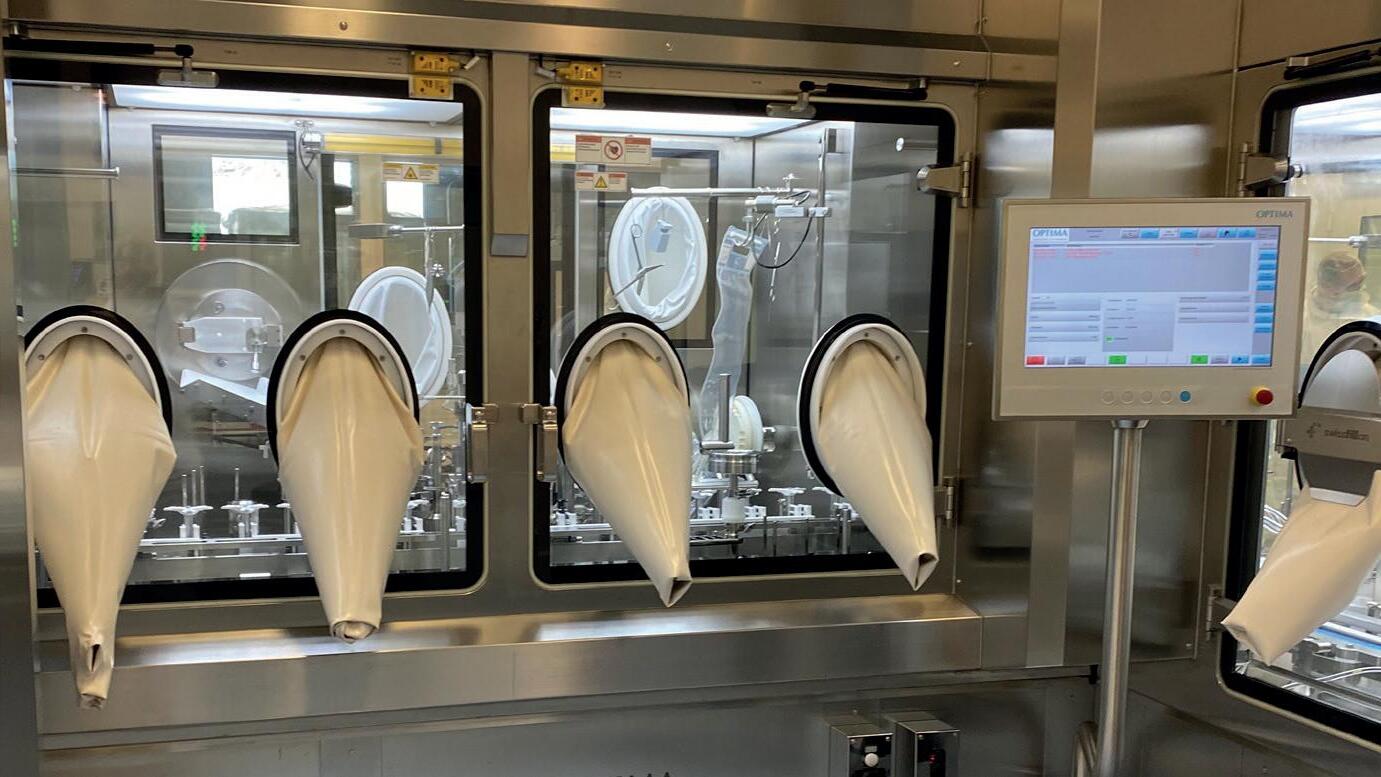
Administration compatibility testing
Syringe development, manufacturing, testing
ten 23 health AG
Mattenstraße 22
4058 Basel, Switzerland
contact@ten23.health
Primary packaging material characterisation
In this article, Yuki Takeuchi, Global Product Manager, PLAJEX™, at Terumo Medical Care Solutions – Pharmaceutical Solutions Division, and Richard Whelton, Vice-President/Head of Business Strategy and Marketing at Congruence Medical Solutions, discuss the challenges of delivering intravitreal injections and how the combination of Terumo’s PLAJEX™ prefillable syringes with Congruence’s Microlitre Dosing Syringe system is able to address them.

Intravitreal injections are used to deliver drugs into the vitreous humour of patients’ eyes. At present, this route of administration is typically used to deliver anti-vascular endothelial growth factor (anti-VEGF) drugs to treat ophthalmic disorders such as age-related macular degeneration, diabetic macular oedema and diabetic retinopathy.
The number of intravitreal injections is expected to continue growing beyond the current estimated 20 million injections per year,1 driven by an increasing number of diabetic patients, a rapidly ageing global population, the entry of biosimilars into the ophthalmic space and the emergence of new treatments for additional conditions, such as geographic atrophy.
Prefilled syringes (PFSs) are widely used for intravitreal injections because of their advantages over vials, including
reduced injection time, possible reduced risk of endophthalmitis and a reduction in intraocular silicone oil droplets.2
Since intravitreal injection is a direct injection into a privileged organ, it faces different requirements and challenges to those of traditional parenteral injection, such as subcutaneous or intramuscular injection. Therefore, thoughtful considerations are needed to select an appropriate drug delivery system to ensure safe and effective treatment. Below is a summary of key considerations for selecting a drug delivery system for intravitreal injection.
Traditionally, silicone oil has been used as a lubricant for syringes to facilitate smooth movement of the plunger stopper within the syringe barrel. However, in the case of ophthalmic drugs, it has been shown that silicone oil can be deposited in the eye’s vitreous humour and accumulate after repeated injections.3
Silicone oil droplets that remain in the eye and are visible to the patient are commonly referred to as “floaters” and avoiding them is one of the key considerations for
Yuki Takeuchi
Global Product Manager, PLAJEX
T: +32 1638 1549
E: katsuyuki.takeuchi@ terumo-europe.com
Terumo Medical Care Solutions –Pharmaceutical Solutions Division Interleuvenlaan 40 3001 Leuven Belgium
www.terumopharmaceutical solutions.com
Richard Whelton Vice-President/Head of Business Strategy and Marketing
E: gs@congruencemed.com
Congruence Medical Solutions 3000 Falls Road Suite 200A Baltimore, MD 21211 United States
www.congruencemedical.com
“The number of intravitreal injections is expected to continue growing beyond the current estimated 20 million injections per year.”
intravitreal injection treatments. Several studies now recommend the use of silicone oil-free syringes for intravitreal injections to address this.4
Ophthalmic drugs are required to follow stricter requirements compared with other parenteral drugs. For example, USP<789> “Particulate Matter in Ophthalmic Solutions” requires ophthalmic drug products to have no more than 50 particles sized ≥10μm per mL, and no more than five particles sized ≥25μm per mL. Silicone oil is also known to be detected as a particle in this context and to have the potential to induce protein aggregation, which further increases particle counts in drug products.5
For most marketed intravitreal injection drug products, the typical administration volume is 50 μL but actual injected volume can vary significantly.6 In one study, presented at the American Academy of Ophthalmology meeting in Chicago, IL, US in October 2018, the mean deliverable dose using a traditional delivery system was shown to be 53.75 mg compared with an expected mass of 50 mg, with a range of 24.6–65.5 mg.7 This can be a significant issue when the therapeutic window is extremely narrow, such as with potent drugs or pre-term neonates diagnosed with retinopathy of prematurity. Additionally, accuracy and precision of the delivered dose are critical to the fidelity of clinical data used to measure drug effectiveness, such as in dose-ranging studies. There are several factors at play when attempting to achieve accurate dosing, such as tight tolerances of the internal diameter of the syringe. For syringes with an external dose mark, the factors impacting dose accuracy also include precise dose mark printing and user-related factors, such as ensuring that the correct part of the plunger is aligned with the marking on the barrel and that the plunger ends in the correct position after injection.
In order to comply with regulatory requirements and mitigate the risk of infectious endophthalmitis, drug delivery systems for intravitreal injection are required to be processed with terminal (postfilling) sterilisation. Therefore, it is critical to select a delivery system that is compatible with a suitable terminal sterilisation method for the finished drug product.
Most injectable drug delivery systems involve some drug wastage, due to overfill, dead space and vial transfer. However, due to the small volumes involved in ocular delivery, the proportion of waste is much greater. For example, a 50 μL dose of Lucentis (ranibizumab, Genentech) requires a fill volume of 165 μL in a PFS format, which equates to 230% wasted dose.3
The percentage waste is even greater when vials are used. Beyond the implication for cost, minimising drug wastage aligns with sustainability objectives.
The number of injections retina specialists need to administer is continuously increasing. This places a focus on solutions that enhance usability, streamline use and improve workflow efficiency, enabling increased patient throughput.
Fewer device use steps enhances usability and may also confer other benefits, such as lowering the risk of exogenous endophthalmitis arising from infection in the eye. Endophthalmitis is considered one of the most serious adverse events related to intravitreal injection, leading to blindness or even patient death.8
There is an increasing number of viscous formulations (>20 cP at room temperature) in the ophthalmology pipeline due to current trends in the pharma industry, such as the shift towards longer-acting drugs to reduce injection frequency and high-strength formulations. These drugs require higher injection forces, which can be problematic with manual intravitreal injections, due to the impact on user control, stability, speed of injection and other usability factors. The use of fine-gauge needles (30G or finer) further exacerbates the problems associated with high injection forces. Unfortunately, conventional approaches to mitigate this, such as using larger needle gauges and increased injection times, have limitations due to the unique circumstances of intravitreal delivery.
In a standard syringe, small doses (<50 μL) result in barely perceptible plunger travel. For example, only one millimetre of plunger movement in a standard 0.5 mL PFS and standard 1 mL long PFS results in the dispensing of 17 μL and 32 μL respectively. A Congruence user study showed that there is an optimal range for injection stroke length, starting above 4 mm (Figure 1). Injection stroke lengths below this can lead to major usability issues, such as uncertainty


Completely Unacceptable
Unacceptable
Somewhat Unacceptable
Somewhat Acceptable
Completely Acceptable
as to whether the dose was started or completed. In some cases, to avoid these issues, pharma companies may undergo expensive and lengthy reformulation efforts to increase the drug volume; however, this is limited by the maximum volume that can be safely injected into the eye.
An option for addressing the challenges in intravitreal injection is to combine a silicone oil-free primary container designed for low-dose applications, such as Terumo’s PLAJEX™ ready-to-fill polymer syringe, and a mechanical, precision-dosing module, such as Congruence’s Microlitre Dosing Syringe (MDS) system, shown in Figure 2.
PLAJEX™ 0.5 mL Luer Lock
Silicone Oil-Free PFS
PLAJEX™ 0.5 mL Luer lock
Silicone oil-free PFS is specifically designed for challenging low-dose PFS products, making it suitable for high-value drug applications, such as intravitreal injection. In this way, PLAJEX™ enables pharmaceutical players to offer a safe, easy-to-use and effective treatment option for patients with ophthalmic disorders. The key advantages of the PLAJEX™ 0.5 mL Luer lock syringe include:
• Silicone oil-free
• Low subvisible particle level
• Tight dimensional tolerance
• Optional clear dose mark for dose confirmation.
The Congruence MDS is designed for applications involving a single manual injection of 5–150 μL. It is a disposable, single-use module that replaces the plunger rod and can be attached to any ISO 11040 compliant PFS. The MDS platform is versatile, with configuration choices that include:
• Pre-set dose (fixed dose, no user choice) or user-set dose (two to four dose volume options)
• Prefilled (syringe is primary drug container) or user filled (vial is primary drug container)
• The user-filled version enables the benefits of superior quality syringes to be made available for drugs where prefilling is not possible.

“An option for addressing the challenges in intravitreal injection is to combine a silicone oil-free primary container designed for low-dose applications, such as Terumo’s PLAJEX™ ready-to-fill polymer syringe, and a mechanical, precision-dosing module, such as Congruence’s MDS.”
Terumo PLAJEXTM
0.5 mL LL
Silicone Oil-Free PFS
Congruence Microlitre Dosing Module
Congruence Microlitre Dosing Syringe

Figure
provide consistent and predictable break loose and glide forces
provide consistent and predictable break loose and glide forces
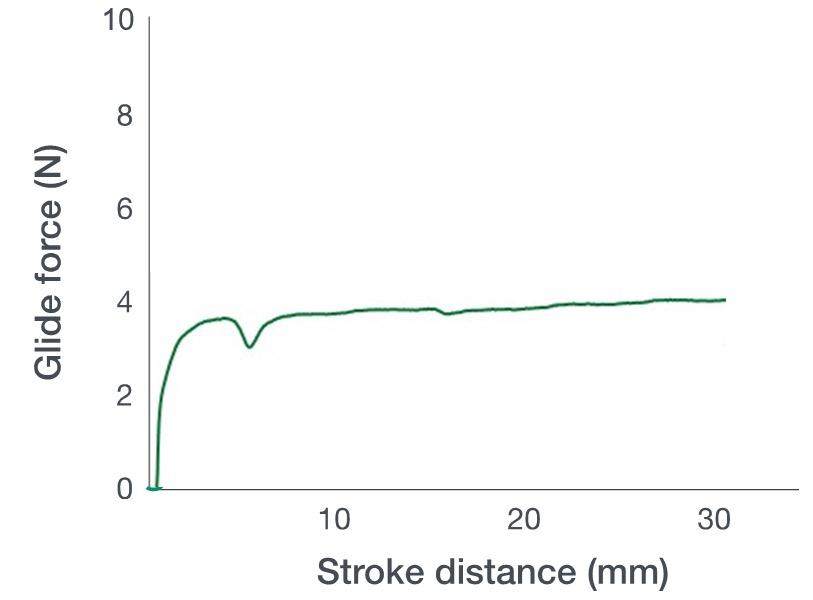
Congruence’s MDS was the recipient of the 2019 Drug Delivery Innovation Award from the Parenteral Drug Association. It can be used for intravitreal injections, as well as other intraocular injection routes, such as subretinal and suprachoroidal.
and predictable glide and injection forces (Figure 3), which can help control microlitre injections.
Low Sub-Visible Particle Count with Manufacturing Excellence
PLAJEX™
Silicone Oil-Free Syringe

Terumo’s proprietary i-coating™ technology eliminates the need for silicone oil in the syringe system, helping to prevent silicone oil being injected into patients. Terumo’s i-coating™ stopper provides consistent
To enable pharmaceutical players to meet the stringent requirements of USP <789>, the PLAJEX™ 0.5 mL Luer lock syringe is supplied with extremely tight subvisible particle specifications (Figure 4). This is enabled by Terumo’s state-of-theart manufacturing processes, which are fully automated to eliminate any human intervention that might introduce particles to the product.
The use of a 0.5 mL syringe, such as Terumo’s PLAJEX™, instead of a 1 mL syringe, has been shown to improve the accuracy of delivering a 50 μL dose. However, this can be further improved by the use of the Congruence MDS device (Figure 5), which has the potential to have up to 25 times greater accuracy than an injection using a 1 mL PFS alone. The MDS has been shown to be able to deliver a dose as low as 5μL accurately (±2.5 μL).
There are various different technologies available for terminal sterilisation of a PFS, such as ethylene oxide (EO), vaporised hydrogen peroxide (VHP) and nitrogen dioxide (NO2). The impact of sterilisation on the stability of drug substances has to be carefully assessed at an early phase of the development to minimise project risks.
According to a study conducted with PLAJEX™, NO2 sterilisation exhibited essentially immeasurable NO2 ingress and no protein degradation, whereas denaturation of proteins was observed with EO and VHP sterilisation.9 The Congruence MDS has demonstrated suitability for sterilisation using E-beam, EO and NO2 methods.
The first step to minimise drug overfill is to have a PFS with tight dimensional tolerances and low dead space. As per a Terumo study, the PLAJEX™ 0.5 mL Luer lock syringe has an inner diameter of 4.69–4.71 mm and residual volume of 10–15 μL (n=45).
A combination of the Congruence MDS with a 0.5 mL PFS was shown to require even less overfill. For example, with the Congruence MDS, instead of a 165 μL fill being required for a 50 μL dose, only 100 μL is needed – saving the equivalent
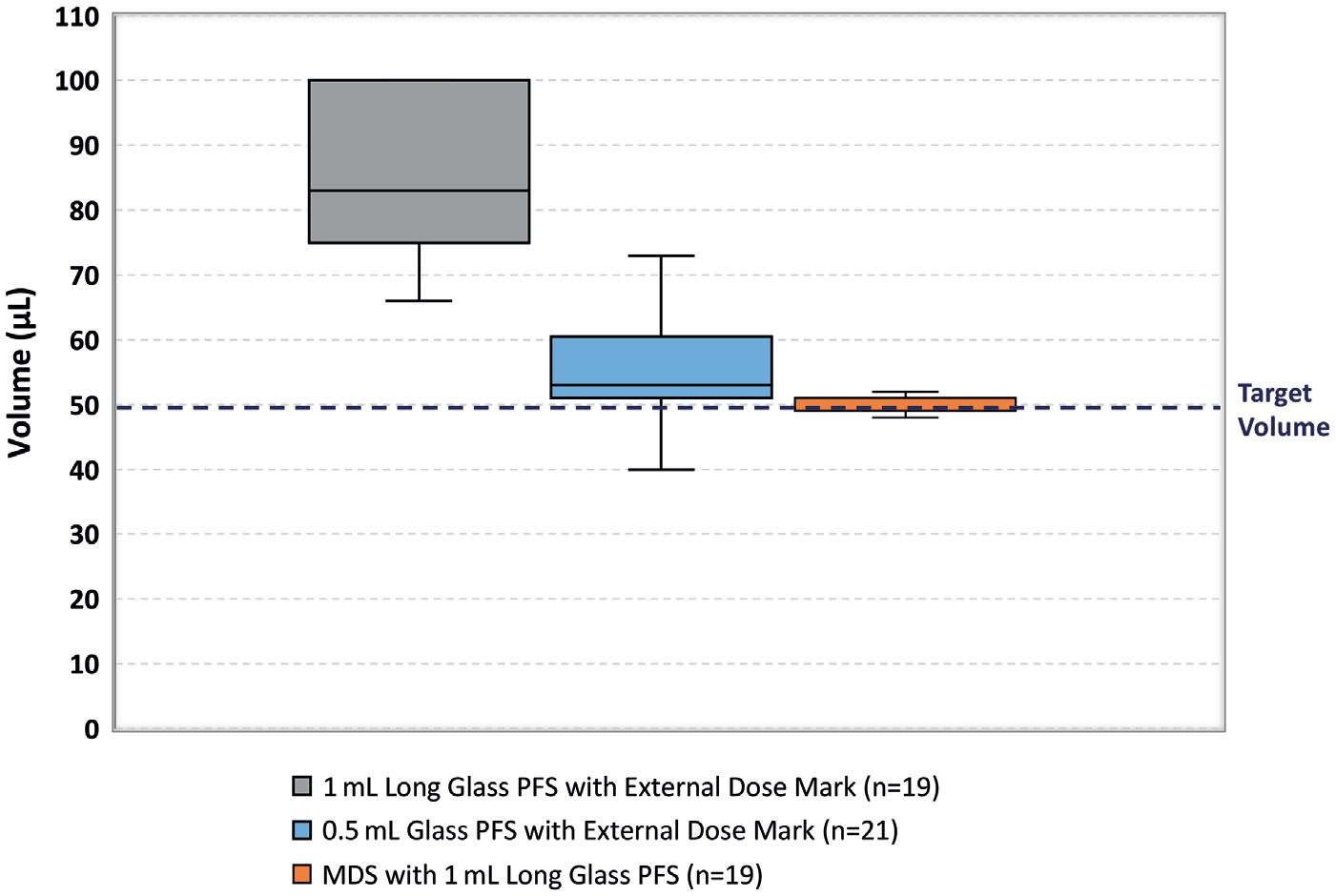
of 1.3 doses. This is possible due to the controlled manipulation of the plunger stopper during priming and dose setting, along with low break-loose force.
Fewer Steps
PFSs involve fewer user steps than traditional syringe and vial solutions and so can help improve workflow efficiency. For example, Lucentis PFSs have been reported to have a 27–39% reduction in syringe preparation time 10 and 57–63% time savings.11 These savings are possible with the Congruence MDS combined with a PFS. Therefore, while the Congruence MDS can be user-filled, prefilled versions convey an additional usability benefit.
“With the Congruence MDS, instead of a 165 μL fill being required for a 50 μL dose, only 100 μL is needed – saving the equivalent of 1.3 doses.”Figure 4: The PLAJEX™ 0.5 mL Luer lock syringe is supplied with extremely low subvisible particle level.
A unique usability feature of the Congruence MDS, due to its inherent mechanical advantage, is the ability to deliver highly viscous drugs with up to a 75% reduction in the injection force experienced by the user, compared with a standard syringe alone, providing a significant usability benefit (Figure 6).
Due to the highly customisable design of the Congruence MDS, it also has the ability to accommodate the optimal stroke length for a given dose volume. This includes amplifying the injection stroke length, even for very small doses. For example, a dose volume of 50 μL in one MDS embodiment, using a 0.5 mL PFS, has a stroke length of 7.4 mm, compared with 2.9 mm for a PFS alone.
The improved performance of the Congruence MDS, as well as other features, such as controlled priming and air bubble removal in one simple step, translate into enhanced usability coupled with high user acceptance and preference. In a global study conducted by Congruence with 30 retina specialists, 100% of the respondents were able to perform all operation steps of the MDS in an error-free manner. Additionally, 87% of the respondents said that they would prefer to use the prefilled Congruence MDS over other currently available delivery options.
Novel drug delivery solutions can add tremendous value to intravitreal injection applications due to the unique challenges for this injection method. The combination of Terumo’s PLAJEX™, a silicone oil-free syringe with tight tolerances designed for low-dose applications, and Congruence’s MDS, a mechanical, manual injection device for a better dosing experience, has many advantages, especially when accuracy and precision is necessary, such as for doses of 50 µL or less, and for drugs requiring high injection forces.
As Part of Terumo Medical Care Solutions, the Pharmaceutical Solutions Division develops patient-oriented parenteral delivery solutions for therapeutic performance and safety. Trusted globally for quality and precision, Terumo offers pharmaceutical and medical device manufacturers around the world comprehensive product design and development services. The company has decades of experience collaborating with pharmaceutical companies from the earliest phases of drug development to product commercialisation to optimise critical aspects of parenteral drug delivery. Innovation and creativity are central to
Terumo’s value proposition. Its expert teams lead the industry in developing and manufacturing advanced, high-performing infusion and injection technologies, including CDMO services for all parenteral applications.
Congruence Medical Solutions’ purpose is to optimise the potential of injectable drugs that have emerging and hard-toaddress delivery needs. Congruence does this by designing, developing and supplying innovative, flexible drug delivery device platforms in partnership with multiple pharmaceutical customers who trust the company’s domain expertise and responsive, innovative approach. Congruence’s growing portfolio addresses compelling problems, including microlitre dosing, viscous drug delivery, multidosing, variable dosing and minimising drug waste.
1. Rimpelä AK et al, “Pharmacokinetic Simulations of Intravitreal Biologicals: Aspects of Drug Delivery to the Posterior and Anterior Segments”. Pharmaceutics, 2018, Vol 11(1), p 9.
2. Baker C et al, “Designing the Ranibizumab Prefilled Syringe for Optimal Safety and Efficiency”. ASRS Annual Meeting 2017 poster presentation, Aug 2017.
3. Khurana RN, Chang LK, Porco TC, “Incidence of Presumed Silicone Oil Droplets in the Vitreous Cavity After Intravitreal Bevacizumab Injection With Insulin Syringes”. JAMA Ophthalmaol, 2017, Vol 135(7), pp 800–803.
4. Olea JL et al, “Silicone oil droplets in repackaged anti-vascular endothelial growth factors for intravitreal injections: In search of the main source of contamination”. Eur J Ophthalmol, 2020, Vol 30(4), pp 774–779.
5. Koshino K et al, “Functional evaluation and characterization of a newly developed silicone oil-free prefillable syringe system”. J Pharm Sci, 2014, Vol 103(5), pp 1520–1528.
6. Loewenstein I et al, “Accuracy and Precision of Intravitreal Injections of Anti-Vascular Endothelial Growth Factor Agents in Real Life: What Is Actually in the Syringe?”. Retina,
2019, Vol 39(7), pp 1385–1391.
7. Meyer CH et al, “Accuracy, precision and repeatability in preparing the intravitreal dose with a 1.0-cc syringe”. Acta Ophthalmol, 2012, Vol 90(2), pp e165–e166.
8. Storey PP et al, “The Impact of Prefilled Syringes on Endophthalmitis Following Intravitreal Injection of
Ranibizumab”. Am J Ophthalmol, 2019, Vol 199, pp 200–208.
9. Fujiwara S, “Chemical-gas Sterilization of External Surface of Polymer-based Prefilled Syringes and Its Effect on Stability of Model Therapeutic Protein”. J Pharm Sci, 2022, Vol 111(1), pp 41–50.
10. Souied E et al, “Ranibizumab


prefilled syringes: benefits of reduced syringe preparation times and less complex preparation procedures”. Eur J Ophthalmol, 2015, Vol 25(6), pp 529–534.
11. Subhi Y, Kjer B, Munch IC, “Prefilled syringes for intravitreal injection reduce preparation time”. Dan Med J, 2016, Vol 63(4), A5214.
Yuki Takeuchi is Global Product Manager for the PLAJEX™ Ready-to-Fill syringe portfolio at Terumo Medical Care Solutions –Pharmaceutical Solutions Division. With extensive knowledge in pharmaceutical science, he has worked in research and development of injectable drug products, such as intravenous solution bags and PFSs, and has contributed to the launch of various products into the market. Using his experience in formulation engineering and industrialisation of injectable drug products, he builds and executes marketing strategy for the primary container portfolio. Mr Takeuchi holds a master’s degree in Pharmaceutical Science from Tohoku University (Sendai, Japan).
Richard Whelton leads strategy and marketing at Congruence Medical Solutions. He has two decades of experience in medical technology, devices and life sciences, and is passionate about improving human health through innovative solutions. Over his career, he has held multiple roles in strategy, innovation and marketing, including a decade at Becton Dickinson & Co, where he developed and commercialised a variety of drug delivery products, including self-injection and infusion devices. Mr Whelton holds an MBA from The Wharton School at the University of Pennsylvania (US) and a master’s degree in Biochemistry from the University of Oxford (UK).
A great place to get the latest updates in regulations & analytical methodologies for extractables and leachables The audience is full of experts. - Thermo Fisher Scientific
In this article, Shiyan Chen, PhD, and Binbin Tian, both Study Directors at WuXi AppTec, discuss the use of oligonucleotides for ophthalmic applications, including their potential uses, advantages, challenges and difficulties when it comes to pharmacokinetic and drug metabolism studies.
Oligonucleotides, or “oligos”, are a class of small, single- or double-stranded synthetic nucleic acid polymers (approximately 20 mer) that can be used to modulate gene expression. They can target pre-mRNA, mRNA or non-coding RNA to induce degradation, modulate splicing events or interfere with protein translation.
Oligos have become a popular therapeutic because of their ability to target previously “undruggable” conditions, including cancers, metabolic disorders and genetic diseases. Specific retinal diseases, such as Leber’s congenital amaurosis, X-linked retinitis pigmentosa and Usher syndrome, have also shown remarkable response to oligo therapy. Ocular oligos can also be used to treat glaucoma, agerelated macular degeneration (AMD), dry eye syndrome, diabetic macular oedema, geographic atrophy and corneal disease. Several oligos have advanced to clinical trials for the treatment of these ocular diseases.
As of 2022, 10 antisense oligos (ASOs), five small-interference RNA (siRNA) and one aptamer have been approved for market use. Compared with the oligo drugs approved earlier by the US FDA, innovations in chemical modifications and delivery systems have greatly improved these drugs’ stability and cellular uptake. However, the eye still remains a popular target for oligo drug development.
While there are diverse groups of oligo therapeutics, they are all negatively charged, hydrophilic and in a similar range of molecular weights:
• ASOs: 4,000–10,000 Da
• siRNA: Approximately 14,000 Da
• Aptamers: 5,000–15,000 Da
• Micro-RNA (miRNA): 14,000–18,000 Da
siRNA consists of small RNA duplexes comprising of “passenger” and “guide” strands, whereas ASOs are single-stranded fragments of nucleic acids (RNA or DNA) that identify targets without the aid of a “passenger” strand. ASOs use the RNase H1 degradation mechanism or splicing modulation mechanism, while siRNAs need the assistance of an RNA-induced silencing complex of proteins to regulate the mRNA degradation.
One major advantage of oligos is their potential to tackle targets that small molecules and protein-based therapeutics cannot. This is due to their unique mechanism of action – oligos primarily rely on Watson-Crick base pairing to the targeted mRNA molecules. This causes gene silencing, a steric block or altered splicing patterns. Aptamers function somewhat differently, folding into three-dimensional shapes, engulfing disease-causing mRNA and inhibiting protein interactions.
Dr Shiyan Chen

Study Director
E: chen_shiyan0101@wuxiapptec.com
Binbin Tian Study DirectorE: tian_binbin@wuxiapptec.com
WuXi AppTec 288 Fute Zhong Road
Waigaoqiao Free Trade Zone
Shanghai China
www.wuxiapptec.com
“Oligos have become a popular therapeutic because of their ability to target previously ‘undruggable’ conditions, including cancers, metabolic disorders and genetic diseases.”
“One major advantage of oligos is their potential to tackle targets that small molecules and proteinbased therapeutics cannot.”
Although small molecules often target membrane receptors and enzymes – and extracellular proteins or membrane receptors can be modulated with monoclonal antibodies – structural proteins or transcription factors are not often “druggable”. However, because oligos act at the DNA or RNA level, they can alter gene expression without regard to the function of the proteins encoded by their target genes. This provides new opportunities to develop innovative ways of reaching therapeutic targets of interest. In principle, oligos can be rationally designed for virtually any genetic target, making them an exciting therapeutic option within precision medicine.
Around a third of blindness or severe visual impairment cases have a genetic basis, either as part of a multifactorial aetiology, such as AMD, diabetic retinopathy or glaucoma, or as the direct result of genetic mutations, such as inherited retinal diseases, inherited corneal dystrophies or optic neuropathies. Historically, some of these genetic eye disorders have been considered incurable. But the expanding knowledge of genotype-phenotype relationship and the growth in oligo therapies, means more oligos to treat them have reached clinical trials, giving hope to millions of suffering patients.
Scientists are justifiably excited about the potential of oligos to treat various diseases, however, their therapeutic application presents unique challenges. Specifically, the combination of the molecular weight of oligos and the eye’s anatomical and physiological barriers results in inefficient delivery to intracellular targets. These barriers can affect drug entry into the eye across multiple routes of administration, including topical, systemic and injectable.
Because the eye is a closed, compartmentalised organ and is relatively small, it requires lower doses to achieve the desired drug concentration for local delivery of siRNA and ASO therapeutics. This can be achieved either by using
topical eye drops or subconjunctival, intracameral or intravitreal injection. Lower doses could also minimise any potential interference with the complicated physiological environments encountered during oligo delivery.
Topical administration in the form of eye drops is preferable for the treatment of anterior segment diseases, as it is convenient and provides local delivery of drugs. However, topical delivery often demonstrates poor drug absorption and low bioavailability. Topical drug delivery to the posterior segment of the eye, such as for for glaucoma or uveitis, and to the anterior segment both demonstrate the same poor drug bioavailability.
Intraocular administration – injecting medicine into the eye – is an alternative method that provides greater bioavailability, drug concentration and cell targeting, but may come with a significant immune response. Failure to properly formulate and dose oligo therapies can result in severe inflammation, unsafe toxicity levels and vision loss.
Ultimately, choosing the most suitable drug delivery method depends on the target tissue. Different routes are more or less appropriate for ophthalmic administration – topical ocular and subconjunctival administration are best used to target the anterior segment, whereas intravitreal administration is better for reaching the posterior segment.
General strategies for improving oligo delivery include chemical or backbone modifications, the use of lipid nanoparticles and the direct covalent conjugation of various moieties that promote intracellular uptake, target the drug to specific cells or tissues, or that reduce clearance from systemic circulation. These include lipids, cholesterol that facilitates interactions with
lipoprotein particles in the circulation; peptides, for improving cell targeting and/ or cell penetration; aptamers; antibodies and sugars. For example, a 2´-O-hexadecyl (C16) conjugated to siRNA enables potent and durable silencing in the eye’s aqueous humour and retinal pigmented epithelium after intravitreal administration.
Models used to study the absorption, distribution, metabolism and elimination (ADME) properties of oligos often include various in vitro and in vivo assays. The most common among these include:
In vitro models:
• Stability in serum or plasma
• Stability in liver S9 homogenates or other target tissue homogenates
• Plasma protein binding
• Metabolite identification in plasma or liver S9.
In vivo models:
• Pharmacokinetic (PK) profile
• Tissue distribution
• Urine, faeces and bile excretion
• Metabolite identification in biological matrices, such as tissue, plasma, urine, faeces, bile and cerebrospinal fluid.
Because oligos are metabolised by nucleases, they are not expected to be metabolised by cytochrome P450 (CYP) enzymes and thus have a low risk of drug-drug interaction (DDI). However, CYP enzyme induction and inhibition studies are still recommended to exclude the possibility of interference with the CYP enzyme. Similarly, studying the inhibition caused by oligos on transporters can provide additional information on DDI.
Diverse bioanalytical platforms are needed for oligo studies, including mass spectrometry, quantitative polymerase chain reaction techniques and fluorescence detectors. In addition to ADME properties, early exploration of the pharmacokineticpharmacodynamic (PKPD) correlation of an oligo will require analysing the target mRNA, target protein or downstream biomarkers.
The small size of the eyes and enhanced bioavailability from local delivery means that only small doses of oligos are required for effective treatment. It is worth noting
“The combination of the molecular weight of oligos and the eye’s anatomical and physiological barriers results in inefficient delivery to intracellular targets.”
“Ultimately, choosing the most suitable drug delivery method depends on the target tissue.”
that the dose level of most ocular oligos is as low as a 100 µg per dose. The selection of appropriate bioanalytical methods with high specificity and sensitivity is critical to achieve accurate ocular PK data on oligos.
Preclinical in vivo models used to test small molecules depend on the species and its congruency with human biology. The anatomy of a rabbit’s eye is similar to that of a human’s, so they are some of the most commonly used animals for preclinical ocular studies. Various studies may require alternative species, but the most useful in vivo models for oligos are non-human primates.
Once the oligo drug is delivered to the eye, as long as the majority of the drug is retained in ocular tissues and the systemic exposure is negligible, scientists can focus more on the in vivo drug distribution and clearance within ocular tissues. Depending on the target tissues of the specific ocular disease, selecting and collecting dissected ocular tissues is critical for evaluating the tissue PK.
For example, fomivirsen was the first ASO approved for treating ocular disease. Following intravitreal administration, the drug was slowly cleared from the vitreous fluid through metabolism and distribution to other ocular tissues. It was also subsequently metabolised by nucleases in digestion, and fomivirsen concentration in the systemic circulation was found to be undetectable.
In another scenario, if the oligo concentration in the systemic circulation is observable, scientists could consider conducting a quantitative whole-body tissue distribution study and an excretion study. Moreover, a plasma protein binding assay could help to understand potential DDIs with other highly protein-bound drugs.
Ocular barriers present significant issues for delivering ophthalmic oligos. Establishing the PKPD correlation in preclinical models is critical for ensuring that the data transfers to clinical studies. The PK processes of ADME determine the lifespan of a drug in the body and the amount delivered to the site of action. Understanding these interrelated processes is critical for deciding a drug’s dose and dosing frequency, thus influencing its efficacy and safety.
Ocular oligo PK studies place very high demands on the comprehensive capability of researchers and scientists. First, expert veterinarians and technicians must be able to perform different ocular administrations, such as intravitreal subretinal injections, and collect complicated ocular tissues. Next, oligos are notoriously unstable and, compared with other small molecules, require specialised handling
Dr Shiyan Chen earned an PhD in Pharmaceutical Science and is a Study Director in the drug metabolism and pharmacokinetic service department at WuXi AppTec. She has extensive research experience in preclinical pharmacokinetics and gene regulation and is currently supporting the preclinical development of multiple oligonucleotide drugs.
Binbin Tian earned an MS in Pharmaceutical Science and is a Study Director in the drug metabolism and pharmacokinetic service department at WuXi AppTec. Her expertise is in preclinical pharmacokinetics, specifically ocular pharmacokinetic evaluation.
and homogenisation conditions for tissue samples. Finally, oligos are diverse and impact biological matrices in different ways. Diverse bioanalytical approaches are often required to accomplish the full drug metabolism and pharmacokinetic characterisation of oligos and fulfil the requirement for high sensitivity.
There is very little official regulatory guidance for oligo drugs and, as noted prior, conducting PK studies on them can be challenging. A lab testing partner that has extensive experience with oligo drugs and comprehensive capabilities using various bioanalytical methods could greatly accelerate drug development in this area.
As a global company with operations across Asia, Europe and North America, WuXi AppTec provides a broad portfolio of R&D and manufacturing services that enable the pharmaceutical and healthcare industry around the world to advance discoveries and deliver groundbreaking treatments to patients. Through its unique business model, WuXi AppTec’s integrated, end-to-end services include chemistry drug CRDMO (Contract Research, Development and Manufacturing Organisation), biology discovery, preclinical testing, clinical research services and cell and gene therapies CTDMO (Contract Testing, Development and Manufacturing Organisation), helping customers improve the productivity of advancing healthcare products through cost-effective and efficient solutions. WuXi AppTec received an AA ESG rating from MSCI in 2022 and its open-access platform is enabling more than 5,900 customers from over 30 countries to improve the health of those in need – and to realise the vision that “every drug can be made and every disease can be treated”.
“Ocular oligo PK studies place very high demands on the comprehensive capability of researchers and scientists.”
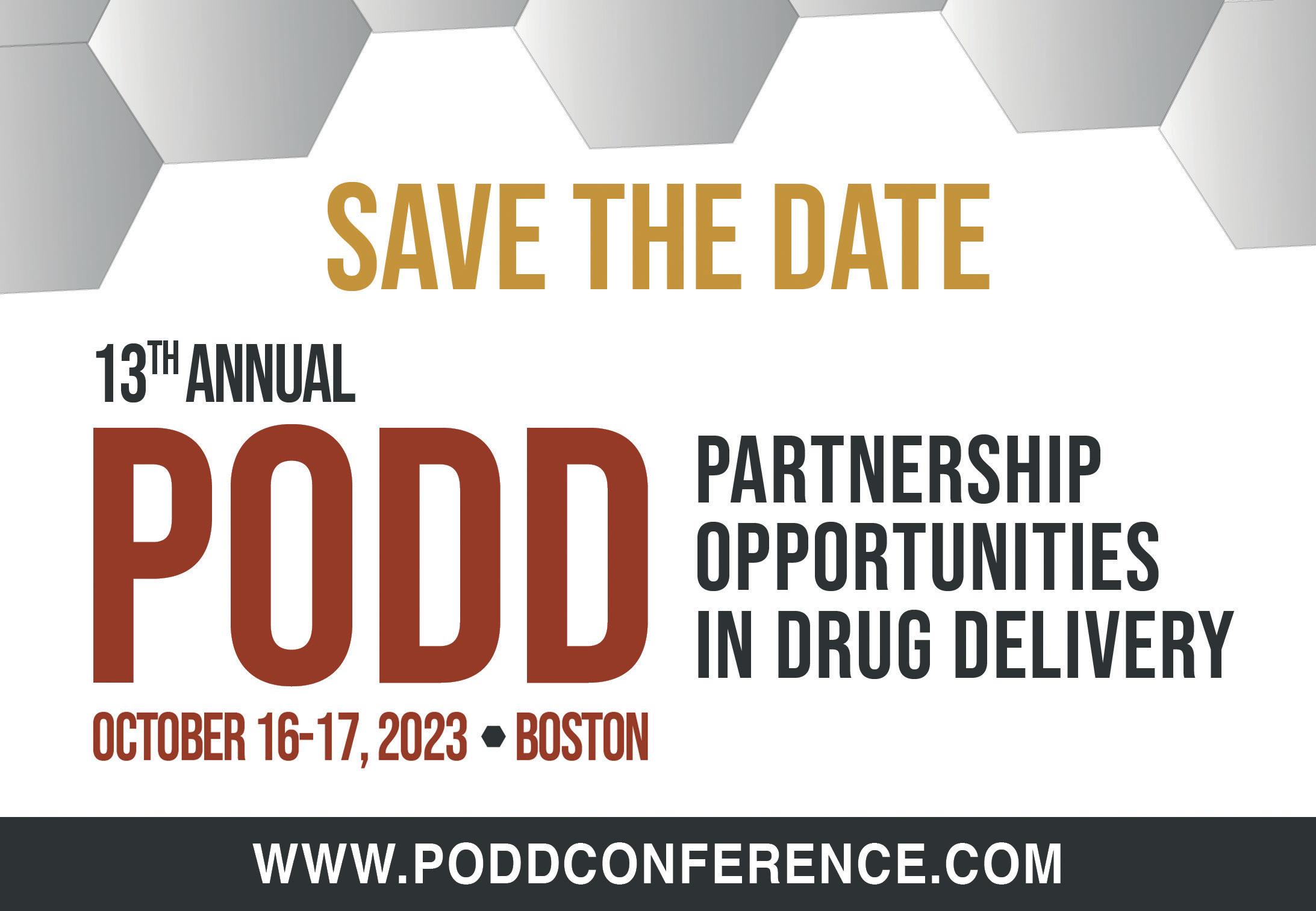


Quality time for better care
To learn how our syringe can accelerate your time to market while securing patient safety and ensuring dose accuracy, visit our website.
